Tuning In INSPIRING COMMUNITY THROUGH MUSIC

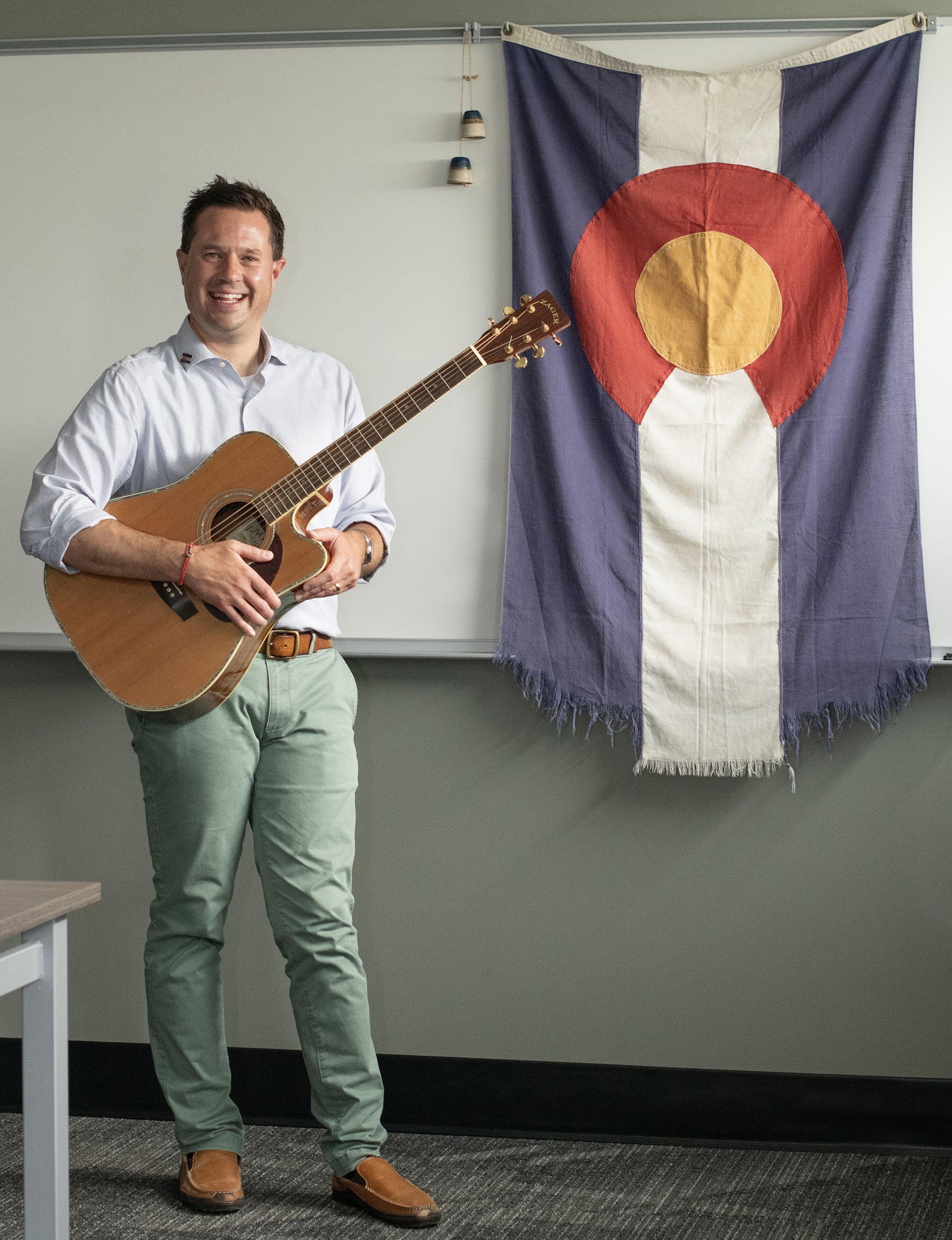
AUGUST 2023
TAKE 5 MINUTES TO GET SMART PG 8 / GRAND VALLEY POWER ON TRACK TO HIT RENEWABLE ENERGY GOALS PG 10
















































Volume Number
THE OFFICIAL PUBLICATION OF THE COLORADO RURAL ELECTRIC ASSOCIATION
COMMUNICATIONS STAFF
Cassi Gloe, CCC, Publisher cgloe@coloradocountrylife.org
Kylee Coleman, Editor kcoleman@coloradocountrylife.org

Ashley Taylor, Editorial Assistant ataylor@coloradocountrylife.org

ADVERTISING
advertising@coloradocountrylife.org | 720-407-0711
National Advertising Representative, American MainStreet Publications 611 S. Congress Street, Suite 504, Austin, TX 78704 | 800-626-1181

Advertising Standards: Publication of an advertisement in Colorado Country Life does not imply endorsement by any Colorado rural electric cooperative or the Colorado Rural Electric Association. Colorado Country Life (USPS 469-400/ISSN 1090-2503) is published monthly by Colorado Rural Electric Association, 5400 Washington Street, Denver, CO 80216-1731. Periodical postage paid at Denver, Colorado. ©Copyright 2023, Colorado Rural Electric Association. Call for reprint rights.
EDITORIAL
Denver Corporate Office, 5400 Washington Street, Denver, CO 80216 cgloe@coloradocountrylife.org 303-455-4111 coloradocountrylife.coop | facebook.com/COCountryLife Pinterest.com/COCountryLife | Instagram.com/cocountrylife Twitter.com/COCountryLife | YouTube.com/COCountryLife1
Editorial opinions published in Colorado Country Life magazine shall pertain to issues affecting rural electric cooperatives, rural communities and citizens. The opinion of CREA is not necessarily that of any particular cooperative or individual.

SUBSCRIBERS
Report change of address to your local cooperative. Do not send change of address to Colorado Country Life. Cost of subscription for members of participating electric cooperatives is 28 cents per month, paid from equity accruing to the member. For nonmembers, a subscription is $15 per year in-state/$20 out-of-state.
POSTMASTER
Monthly Contests
classes.
Does your family like to hike? Do you need inspiration and new trails to explore? Enter to win one of these books!


For official rules and to enter, visit the Monthly Contests page at coloradocountrylife.coop or scan the QR code with your smartphone.

INSTAGRAM PIC of the month colorado_electric_cooperatives posted: Nearly 100 high school students arrived in Clark, Colorado, after being selected by their local cooperatives as participants for the Cooperative Youth Leadership Camp. This educational seminar is put on by electric cooperatives in Colorado, Kansas, Oklahoma, and Wyoming.

#LeadersOfTomorrow #CooperativeDifference
FACEBOOK CHATTER
Colorado REA Facebook posted: Yesterday, attendees enjoyed the first day of the 2023 Safety & Loss Control Seminar. Presentations included topics such as physical security, DOT requirements, and hazard mitigation planning. Participants also engaged in breakout discussions and lunch. Here’s to a successful day 2!
#SafetyAndLossControl #Seminar #CREA

coloradocountrylife.coop
Life
Washington Street, Denver,
On the Cover 20 ENERGY CONNECTIONS 22 GARDENING 24 OUTDOORS 26 FOCUS ON 28 MARKETPLACE 29 YOUR STORIES 30 DISCOVERIES 4 VIEWPOINT 5 LETTERS 6 ASK THE ENERGY EXPERT 7 YOUR CO-OP NEWS 12 RECIPES 14 NEWS CLIPS August 2023 54 08 AUGUST 2023 Tuning In INSPIRING COMMUNITY THROUGH MUSIC
COVER STORY TUNING IN
Send address changes to Colorado Country
5400
CO 80216
16
“Mexican Hats” by Kerry Howard, a La Plata Electric Association member.
Yuma High School music teacher Rob Zahller poses with his guitar between
3 COLORADO COUNTRY LIFE AUGUST 2023
Photo by Thea Sonnenberg, Big Country Photography.
BEHIND THE METER
How does at-home energy generation impact the grid?
BY KENT SINGER EXECUTIVE DIRECTOR

Since the inception of the Colorado electric co-op program in the 1930s, the traditional path for delivering electricity to co-op members has largely remained the same: Power is generated at a central station power plant, transmitted across high voltage transmission lines, and finally distributed over a local system to end-use customers at their homes and businesses. While the source of the “central station” power varies from state to state, the basic system of generation, transmission and distribution (G,T&D) of electricity has looked the same for decades.
This “G,T&D” model will remain the path for most of the electricity consumed by Colorado’s electric co-op members for years to come; however, more and more co-op members are opting to generate electricity at their premises. They do this by using solar panels on their rooftops or other sources of power that are “behind the meter.” And, as is the case for most renewable energy generation, it’s not always available and fluctuates depending on weather conditions. With that in mind, there are two scenarios at play for a co-op member’s on-premise system: Excess generation and inadequate generation.
If a co-op member’s residential rooftop solar system produces more electricity than they consume, Colorado’s electric co-ops have agreed to — and state law requires them to — “net meter” the energy the co-op receives from member-owned solar arrays. Net metering simply means that when excess electricity is exported to the grid, the co-op member receives kilowatt-hour credits valued at the retail rate. A member of a Colorado electric co-op can reduce
the amount of electricity they purchase from the co-op since the solar panels on their rooftops are producing at least some, if not all, of the power they require for their home or business. In this scenario, the co-op member who is generating excess electricity benefits from their use of the co-op distribution system to manage and credit their excess solar energy production.
Unless they are completely off the grid and are generating all the electricity they need, co-op members with rooftop solar systems must still be connected to the co-op’s distribution infrastructure. This ensures the delivery of electricity to their home or business whenever it is required — for example, during a string of cloudy days when their solar panels don’t generate adequate electricity. Electric co-ops have a legal obligation to maintain adequate facilities in order to provide reliable electric service to their members.
It’s true that the need for a co-op to purchase power from a wholesale supplier is decreased when its members generate their own electricity. However, the co-op is still responsible for maintaining a robust distribution system that will serve all the co-op’s members.
This raises an important question for Colorado’s electric co-ops (and other electric utilities): If an electric co-op member benefits from the poles and wires to provide electricity when the rooftop solar panels aren’t sufficient, but that member no longer buys any or as much power from the co-op, should that member be required to pay for the continuing maintenance and replacement costs of those facilities?
KENT SINGER
As more and more co-op members install solar arrays, the way that co-ops compensate their members for consumersited generation may need to be reexamined. With the increase in residential solar systems, co-ops receive less revenue from energy sales, but they continue to have expenses related to maintaining the distribution grid. Co-ops may also need to make new infrastructure investments to enable the storage of excess solar production to help meet peak demands for electricity in the afternoon.
There has been a lot of discussion recently about whether any changes need to be made to the existing net metering rules from both the perspective of solar installers and electric utilities. As not-forprofit utilities, co-ops aren’t incentivized to make a profit, but they still must meet their payrolls, run their trucks, and invest in system maintenance and improvements. These costs are shared among all co-op members.
Colorado’s electric co-ops go to great lengths to treat all of their members fairly and equitably, and they will continue to do so as they integrate more behind-themeter, customer-sited renewable energy resources.
4 COLORADO COUNTRY LIFE AUGUST 2023 VIEWPOINT
Kent Singer is the executive director of CREA and offers a statewide perspective on issues affecting electric cooperatives. CREA is the trade association for 21 Colorado electric distribution co-ops and one power supply co-op.
FROM THE EDITOR
Supporting Future Leaders
BY KYLEE COLEMAN EDITOR KYLEE COLEMAN
Did you know that seven cooperative principles guide your local electric co-op’s daily work and mission? Each principle contributes to the cooperative difference — the “it” factor — that sets it apart from other utility companies. Maybe you’ve experienced this difference already, but I want to highlight how two specific cooperative principles impact you and your family: “Education and Training” and “Concern for Community.”
Your local electric co-op recognizes that kids are the leaders of the future. It invests in education that benefits kids, families, and their local communities. Some examples of this include presenting electrical safety demonstrations at schools and community events; donating time and money to local nonprofit educational organizations and programs; sponsoring junior livestock sales; and giving college scholarships to graduating seniors.
When co-op principles are combined in action, it results in powerful and lasting change for co-op members and communities. I encourage you to look closely — I’ll bet you discover the cooperative difference for yourself. Connect with your local electric co-op on its website to learn more about cooperative principles and programs.
Kylee Coleman is the editor of Colorado Country Life magazine.

I have read that if the blade on the power windmills is painted, the birds won’t fly into it.
Is that true?
If so, why isn’t it required for all of the windmill farms?
Gail Shepherd, Pueblo West San Isabel Electric Association member
EDITOR’S NOTE:

The visual effect we experience when a fast-moving object appears blurry is called “motion smear.” Painting one of the three turbine blades black could potentially reduce bird collisions by providing a visual cue and reduce motion smear. But keep in mind that these visual cues for birds are only effective during the daytime. Certain studies are promising but have not been duplicated; there is no firm evidence that painting blades reduces the number of bird collisions with wind turbines.
To learn more about Colorado’s electric cooperatives’ efforts to protect birds, visit www.coloradocountrylife.coop/ safeguarding-wildlife.
Editor, 5400 Washington St., Denver, CO 80216 or kcoleman@coloradocountrylife.org. Include name and address. Letters may be edited for length.

COLORADO’S ELECTRIC COOPERATIVES JUNIOR
LIVESTOCK SALE
Tuesday, August 29 at 3:30 p.m. In-person and online bidding available
The Colorado State Fair is inviting you to enjoy MOUNTAINS OF FUN this year! Come experience the best Colorado has to offer with authentic livestock competitions, live music, and all the delicious fair food you love.


Go to coloradostatefair.com to find the schedules for this year’s Junior Livestock Sale, rodeo and concerts!
AUG 25TH - SEPT 4TH
US YOUR LETTERS
SEND
LETTERS TO THE EDITOR
5 COLORADO COUNTRY LIFE AUGUST 2023 LETTERS
TEACH YOUR CHILDREN WELL
BY MIRANDA BOUTELLE
Q: I’m making an effort to reduce my energy use, and I want my kids to start energy-saving habits as well. How can I encourage them to use less electricity at home?
A: Educating kids on energy use and costs can help engage them in your family’s goal to use less electricity. They can be electric conservation champions if you ask them to help.

A great place to start is to teach children the impact of saving energy; have them help you conserve with the household’s biggest energy users: heating and cooling systems. Set the example and dress appropriately for the seasons, even when indoors — socks and sweaters in the winter, tank tops and shorts in the summer. Clothing choices impact thermostat settings that can balance comfort and savings.
This time of year, you can also leave the house during the hottest times of the day to go for a swim or play outside. Before you go, nudge up the thermostat a few degrees to avoid cooling an empty house.
The second-highest use of electricity is typically an electric water heater. Use a shower timer so older kids can monitor how long they are in the shower. Teach them to wash their clothes in cold water. If you have a gas water heater, look at the gas bill to find opportunities to save.
Powering down gaming stations and computers is another way to save. In the
kitchen, keep the refrigerator door shut. Teach kids to take a quick peek and shut the door while they think about their snack options.
If your kids are older, spend some time teaching them how to read the electric bill. Focus on what you can control: kilowatthour use. If they are old enough, teach them how to do the math. Calculate kWh use by multiplying wattage by hours used and dividing by 1,000. Multiply this by the kWh rate found on your electric bill to estimate how much you spend on power for each household appliance.
For example, if you have a space heater that uses 1,500 watts and is on for four hours a day for one month, it uses 180 kWh. With an average rate of 13.1 cents per kWh in
Colorado, the space heater costs about $25 a month to operate. In this example, that same space heater costs more than $70 per month if runs 12 hours a day.
For household appliance wattage, look for the amount stamped on the bottom, back, or nameplate. If the nameplate does not include wattage, figure it out by multiplying the voltage by the amperage.
For more information on how to save on your electric bill, visit your electric co-op’s website.
Miranda Boutelle is the chief operating officer at Efficiency Services Group in Oregon, a cooperatively owned energy efficiency company. She has more than 20 years of experience helping people save energy at home, and she writes on energy efficiency topics for the National Rural Electric Cooperative Association, the national trade association representing more than 900 electric co-ops.
Teach kids to dress appropriately for the seasons, even when they are indoors, which allows you to set the thermostat to balance comfort and savings.
Photo by Mike Teegarden, Pioneer Utility Resources.
6 COLORADO COUNTRY LIFE AUGUST 2023 ASK THE ENERGY EXPERT
IF I CAN, YOU CAN
BY TOM WALCH CHIEF EXECUTIVE OFFICER

It has not escaped my notice that I am now “the crusty old guy” in the office who gets poked fun at for my avoidance of some types of technology. But who could blame me? When I first entered the workforce not quite an eon ago, we picked up a telephone to reach out to colleagues and typed final reports on a typewriter, always with a bottle of Wite-Out nearby.
I may not think to click open my instant messaging software to send a quick message to a Grand Valley Power employee, but I’ve got email. Typing correspondence on a computer keyboard could even be said to revive nostalgic feelings were it not for the lighter touch required to depress the keys.
Looking at it from another perspective, I’m not all that crusty. I’ve embraced some up-and-coming technology. For example, my wife and I use various social media outlets to stay in touch with our kids and grandkids. For handling estate matters from afar, using electronic signature platforms has been a big time-saver for us.
Understandably, the rate with which I adopt technology is directly related to:
1. Its usefulness, and
2. Its ability to seamlessly integrate into my life.
When we at GVP consider technologies that might help our members, we pit new tech against these two requirements. We want to ensure that the tools we offer our members add value to their lives and serve a purpose. SmartHub is one of those tools.
SmartHub is the software program that GVP and many other electric utilities provide to members for account access. Our members can use SmartHub to manage their account, pay bills, monitor their usage, and report issues. SmartHub meets the usefulness requirement: Consumers can view their energy usage — broken down by on- and off-peak — and compare energy
used over a specific time to make informed decisions about energy consumption. SmartHub also integrates easily into the tools most of us already use: The mobile app is on smartphones and the online software is a click away from our gvp.org website.
Another reason why our members should use it? SmartHub offers an additional feature that benefits both individual members and our cooperative as a whole. Let me expound on paperless billing.
First, as a member of GVP, you should understand that mailing bills and processing paper payments (for example, checks) comes at a significant cost to the cooperative. And because you as a member are also an owner and participate in the economics of our not-for-profit business, the mailing and processing of bills comes at a cost to you.
Consider postage. Since 2019, stamp prices have risen 32%, including a 3-cent increase that went into effect just last month. GVP pays metered and bulk mail rates for most of its mailings, but these rates have increased incrementally alongside First-Class stamp prices. This increase in postage is only part of the equation. Other expenses for paper bills include purchasing the paper and envelopes, printing the bills, and paying employees for the time that it takes to process payments we receive by check. These expenses add up to a significant amount of money that could be saved or used for other purposes.
Since I took the plunge into paperless billing, I have found that it not only reduces the bulk in my mailbox, but it also helps eliminate the clutter that paper adds up to in my house. Combined with automatic bill payment through my bank account, I also save the time it would have taken me to write a check and the postage it would cost to mail it.
TOM WALCH
It is easy enough to make the switch to paperless billing in SmartHub. Simply log in to the mobile app or online and navigate to “Paperless” settings. And when you want to see your bill? Simply log in to SmartHub and view any bill going back several months. SmartHub even sends an email or text notification prior to the automatic payment going through so that you won’t miss anything.
After a couple of months of getting into the habit of paperless billing, this “crusty old guy” won’t go back to paper. SmartHub is a technological tour de force and a win-win for both members and the cooperative.
COMMENTS TO THE CEO
You are a member of a cooperative and your opinion counts. If you have any questions, concerns, or comments, please let me know by writing to Ask the CEO, P.O. Box 190, Grand Junction, Colorado 81502, or send an email to me at twalch@gvp.org. Visit our website at gvp.org.
BOARD MEETING NOTICE
Grand Valley Power board meetings are open to members, consumers, and the public. Regularly scheduled board meetings are held at 9 a.m. on the third Wednesday of each month at the headquarters building located at 845 22 Road, Grand Junction, Colorado.
The monthly agenda is posted in the lobby of the headquarters building 10 days before each meeting and posted on the GVP website. If anyone desires to address the Board of Directors, please let us know in advance, and you will be placed on the agenda.
7 COLORADO COUNTRY LIFE AUGUST 2023 YOUR CO-OP NEWS
Take Five Minutes to Get Smart
 BY RITA-LYN SANDERS DIRECTOR OF MARKETING AND COMMUNICATIONS
BY RITA-LYN SANDERS DIRECTOR OF MARKETING AND COMMUNICATIONS

Growing up, I lived in the same town as my grandparents, making our visits a convenient pastime. For a few years, our house was just a stile’s climb away from theirs, across a couple of small pastures dotted with cows and sheep. Not yet in school, my brother and I would race to see who could get there the fastest. We didn’t knock. Usually my grandma, also named Rita, would see us coming and have treats at the ready long before we smashed our freckled faces against the glass backdoor. Even when my grandparents left the farmland behind for a lower-maintenance option in town, my brother and I would
still find ourselves at their place during our parents’ date nights. Those evenings were magical. Lounging on the living room floor, we’d watch reruns of silly television shows from the 1960s, and grandpa George would set the popping corn on the stove in a double-handled Revere Ware stockpot coated with oil. It was the same pot he had entrusted with the task since before I was born. I still make popcorn this way today — it hands down has the best flavor — and fondly think about the time we spent together back then, just laughing at silliness.
RITA-LYN SANDERS
and Agent 99 took the spy genre of the 1960s beyond jetpacks and dagger shoes to invisibility spray and shoe phones. The latter, of course, was quite the visionary gadget, giving credence to the characters’ intelligence despite their best efforts to bumble through the operations of their top-secret government agency. Little did their team of ingenious inventors know they were onto something before its time.
Smart

One show that generated a great deal of guffaws was “Get Smart.” Maxwell
Of course, today we do not have to take off our shoes to use our mobile phones.
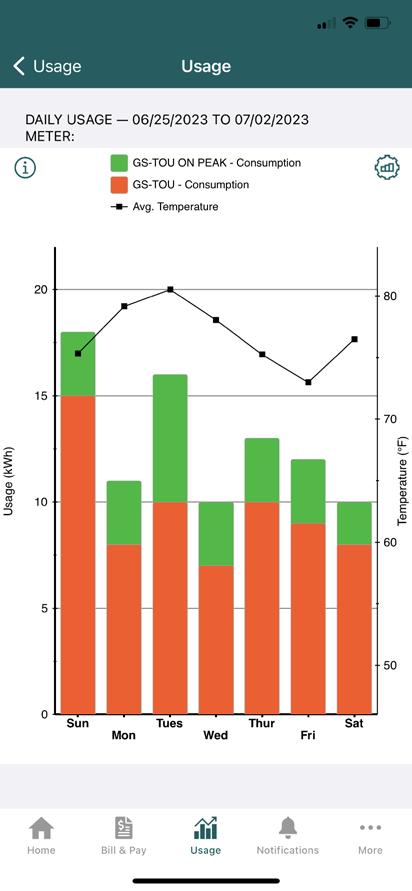 As a powerful and intuitive app, the SmartHub mobile app homescreen offers simple navigation buttons for billing and payments, usage, and notifications.
This is what a summary of weekly usage looks like in the SmartHub mobile app.
As a powerful and intuitive app, the SmartHub mobile app homescreen offers simple navigation buttons for billing and payments, usage, and notifications.
This is what a summary of weekly usage looks like in the SmartHub mobile app.
8 COLORADO COUNTRY LIFE AUGUST 2023 YOUR CO-OP NEWS
SmartHub shows a detailed graph of daily electricity usage in kilowatt-hours, including on-peak and off-peak consumption.
These ubiquitous minicomputers not only give us the means to connect with each other; they also connect us to a world of web servers and programs that make it easier than ever to educate ourselves with information that ultimately helps us make the best decisions for our situation.

One such program is SmartHub, an online tool that puts members in control of their energy decisions. Its goals are to empower you with usage data so you can make the best decisions for your situation and to provide easy access to payment options and account management. Plus, you can report an outage in the SmartHub app — a convenient feature for when your power goes off and you need to let us know quickly.
All you have to do is take five minutes to download SmartHub on your phone or navigate to it on the internet and then access your account. Two of the best life efficiencies that I’ve discovered on SmartHub are the auto pay and paperless billing features. Like Maxwell Smart and Agent 99, these two features make a powerful duo. By signing up for auto pay and paperless billing, I save my
How to Install SmartHub on Your Smartphone
cooperative (and ultimately, all members) money on postage, the printing of bills, and the time it takes for a GVP employee to process the paper payment by hand. Plus, I receive email and text alerts when my GVP payment has gone through and for how much, so I’m not missing any information that would have been on a paper bill. An additional bonus of going paperless is that its eco-friendly and reduces the amount of paper I have in my files. And if I ever need a hard copy of my bill, I can see previous bills in SmartHub and print one anytime.
The personal benefits of SmartHub go even further. I can tap into the SmartHub app on my phone at any time and see my energy usage by day, month, or week. I can see how my use breaks down during on- and off-peak hours so I know if I need to change the temperature on my thermostat or declare an electronics-free day to save on energy costs. I can take a much deeper dive into my energy usage on SmartHub than what I can see on a paper bill, and I can do it at my convenience anywhere I have my phone.
Some of the ways you can use SmartHub to empower your life are:

• Automate your bill payments

• Go paperless
• Set up notifications to alert you when your energy usage reaches a specific threshold
• Take a deep dive into when and how much energy your household consumes
• Report an outage
If you take just five minutes to set up your SmartHub account, you will have the power to simply tap into your energy tools anytime you like.
For more detailed instructions for how to set up a SmartHub account and navigate through components of the app, visit gvp.org/SmartHub.
2023 Grand Valley Power Annual Meeting - Thursday, August 3; 5:30 p m - 8:00 p m August Board Meeting - Wednesday, August 16 Mugs for Mobility - Go Baby Go Fundraiser - Thursday, August 17; 11 a m - 10 p m Labor Day (Office Closed) - Monday, September 4
CO-OP CALENDAR
Navigate to your app store.
SmartHub
the SmartHub
Tap
Valley Power in the
If you have an account,
in
gvp.org/SmartHub
1.
2. Search for
and follow the instructions to install the app on your device. 3. Open
app and search for your provider by location (Grand Junction, CO) or name (Grand Valley Power). 4.
Grand
search results and then tap “Confirm.” 5.
log
with your username and password. If you don’t have an account, visit
for instructions on how to set up an account.
FILL THE CAR Here's How You Can Help: Visit gvp org/hometownpartnerships Click "Donate Now" Support Go Baby Go! SUPPORT GO BABY GO 9 COLORADO COUNTRY LIFE AUGUST 2023 YOUR CO-OP NEWS
GRAND VALLEY POWER ON TRACK TO HIT RENEWABLE ENERGY GOALS

 BY DESTRY SMITH ENERGY SERVICES ADMINISTRATOR
BY DESTRY SMITH ENERGY SERVICES ADMINISTRATOR












The energy that Grand Valley Power delivers to member homes and businesses comes from renewable resources more now than ever before. The portion of GVP’s energy portfolio that comes from renewables was 48.2% in 2022, a 7% increase from the previous year.
GVP files its report on renewable energy standards, also known as renewable portfolio standards, with the Colorado Public Utilities Commission every year. Colorado, one of the first states to implement a renewable energy standard, requires utilities to purchase a certain share of their electricity from designated renewable resources including wind, solar, geothermal, biomass, and hydroelectricity. For GVP, that requirement is 10% of the total power that it purchases. Colorado has increased this standard as the industry transitions to clean energy; however, GVP has always exceeded its requirement. In fact, since 2019, GVP has seen a steady increase in the percentage of electricity generated by renewable resources it purchases.
To derive its percentage of renewable energy, GVP accounts for the number of megawatt-hours sourced from designated renewable resources during the year and divides that number by the total megawatt-hours it sold during the same period. Most of the renewable resources that GVP uses in the filing are assigned by
SMITH


its wholesale power provider, Public Service Company of Colorado. The wind and solar resources that PSCo assigns to GVP are significant. On a local level, GVP purchases hydrogeneration directly from Ute Water. GVP’s net metering members also contribute to the number of renewable resources that GVP reports. Ultimately, GVP is in great shape to reach its goal of a 60% renewable power supply mix by 2030.
Destry Smith is GVP’s energy services administrator. Prior to this role, he worked in the field as a GVP journeyman lineman. A graduate of Colorado Mesa University with a Bachelor of Business Administration degree, Destry also completed the Electrical Lineworkers Program at Western Colorado Community College. His education and work in the field as a lineman has prepared him to serve in GVP’s member services department as your trusted energy advisor.

MUGS F O R Mobility @GVRuralPower 17 11-10 A.M. EEK BREWING COMPANY t, Grand Junction, CO 81501 Go Baby Go, a project dedicated to giving o children with disabilities, made possible sa University and Family Health West. P.M. aft beer and support Go Baby Go. DESTRY
W E S T E R N C O L O R A D O C O M M U N I T Y C O L L E G E
10 COLORADO COUNTRY LIFE AUGUST 2023 YOUR CO-OP NEWS
2023
LINEWORKER 2023 LINEWORKER
How a Safe Step Walk-In Tub can change your life
Remember when…
Think about the things you loved to do that are dif cult today — going for a walk or just sitting comfortably while reading a book. And remember the last time you got a great night’s sleep?
As we get older, health issues or even everyday aches, pains and stress can prevent us from enjoying life.


So what’s keeping you from having a better quality of life?
Check all the conditions that apply to you.
Personal Checklist:
Arthritis Dry Skin
Insomnia Anxiety
Diabetes Mobility Issues
Lower Back Poor Pain Circulation
Then read on to learn how a Safe Step Walk-In Tub can help. Feel better, sleep better, live better
A Safe Step Walk-In Tub lets you indulge in a warm, relaxing bath that can help relieve life’s aches, pains and worries.
A Safe Step Tub can help increase mobility, boost energy and improve sleep.


It’s got everything you should look for in a walk-in tub:
• Heated Seat – Providing soothing warmth from start to nish.
• MicroSoothe® Air Therapy System – helps oxygenate and soften skin while offering therapeutic bene ts.


• Pain-relieving therapy – Hydro massage jets target sore muscles and joints.
• Safety features – Low step-in, grab bars and more can help you bathe safely and maintain your independence.






• Free Shower Package – shower while seated or standing.



THERAPY, SAFETY AND INDEPENDENCE
Personal Hygiene Therapy System and Bidet Wider Door, The Industry’s Leading Low Step-In Foot Massaging Jets Anti-Slip Tub Floor Complete Lifetime Warranty on the Tub Safe Step includes more standard therapeutic and safety features than any other tub on the market, plus the best warranty in the industry: Heated Seat and Back CSLB 1082165 NSCB 0082999 0083445 New Rapid Fill Faucet MicroSoothe® Air Therapy System Electronic Keypad 16 Air Bubble Jets Call now toll free 1-800-990-1419 for more information and for our Senior Discounts. Financing available with approved credit. FREE SHOWER PACKAGE PLUS $1500 OFF FOR A LIMITED TIME ONLY Call Toll-Free 1-800-990-1419 With purchase of a new Safe Step Walk-In Tub. Not applicable with any previous walk-in tub purchase. Offer available while supplies last. No cash value.Must present offer at time of purchase. www.BuySafeStep.com Scan me
Quick-Prep Grab and Go Banana PB&J Wraps
BY KYLEE COLEMAN
It’s back-to-school time! This may mean your family is shifting from easy summer days to the rush of the bus schedule and the school bell. Courtesy of Catherine Murray at our sister publication, Ohio Cooperative Living, we’re excited to share her “Grab and Go” recipe for Banana PB&J Wraps.

Spend a Sunday afternoon with your kids prepping these wraps. Set it up as an assembly line — you’ll have fun and be set for a few days of the coming week. With this advance work, these wraps are the perfect solution to a rushed morning, a cure for a “hangry” kid who needs a pick-me-up after a long day at school, or an eat-inthe-car snack on the way to an after-school activity. We hope this delightful recipe helps you ease back into your school routine.
BANANA PB&J WRAPS

Prep: 5 minutes | Servings: 2
1 8-inch flour tortilla
1 ounce cream cheese
2 tablespoons chunky peanut butter
1 tablespoon jelly or jam of choice
1 large banana, peeled
Warm up flour tortilla in microwave for 10 seconds to make it easier to roll without cracking. Spread cream cheese evenly over half of the tortilla (to the edges). Spread the peanut butter on the other half (to the edges). Spoon and spread jelly down the middle, then place banana on top. Roll up tightly and seal. Cut in half lengthwise to share. Off you go with a tasty and filling snack! Store in foil, plastic wrap, or food storage containers in the fridge for up to three days.
Note: Adjust measurements to your liking — you know your perfect PB&J ratio! Switch out the peanut butter for almond butter or sun butter if you prefer.
GET MORE RECIPES ONLINE

WHO INVENTED THE PB&J?

In 1901, the first peanut butter and jelly sandwich recipe appeared in the Boston Cooking School Magazine of Culinary Science and Domestic Economics written by Julia Davis Chandler. She said to use currant or crab-apple jelly and called the combination delicious and as far as she knew, original. nationalpeanutboard.org

DO YOU HAVE A GREAT RECIPE?
If you have a recipe you want us to try, send it to recipes@coloradocountrylife.org.
A NOTE ABOUT JULY'S PIZZA PASTA SALAD RECIPE
Last month’s recipe excerpt was from Hot Diggity Dog: 65 Great Recipes Using Brats, Hot Dogs, and Sausages by Eliza Cross. Photography by Sheena Bates. Reprinted by permission of Gibbs Smith Books.
 Recipe and photo by Catherine Murray, Ohio Cooperative Living.
Recipe and photo by Catherine Murray, Ohio Cooperative Living.
Looking for another quick and easy to make after school snack? Try Dessert “Sushi.” Visit coloradocountrylife.coop, click on Recipes under Living in Colorado, and search for Dessert “Sushi” or scan the QR code to the right. 12 COLORADO COUNTRY LIFE AUGUST 2023 RECIPES
The Miracle of Hemp in a Pill?
Americans are rejoicing about a brand-new technology that gets the goods on the health benefits of hemp.
A next generation hemp technology is now available across the nation and can be purchased without a prescription.
And the best part, it comes with a new delivery system that’s 450% more absorbable than oil.
So you can say good-bye to pills, oils and creams.
Canna LS contains pure “full spectrum hemp,” which works to relieve joint discomfort, restore sharp memory, and support a healthy normal inflammatory response, to name a few. And since it has no THC, it heals without the “high.”
Exciting new scientific research shows that hemp contains special molecules called cannabinoids which bind to receptor sites in the brain and body. When taken orally, hemp activates these receptors.
Why This New Technology Is Better Than Hemp
Unfortunately, most hemp found on the market can’t deliver a fraction of these results. “The problem is, most hemp formulas come in oil form,” according to Chief Technologist Mi Hwa Kim of The Green Gardener. “Oil doesn’t breach the cell membrane, which is where the real healing happens. Our body is 80% water, our cells 90%. And you know what they say about oil and water — they don’t mix.”

This is why Canna LS contains a unique “water soluble” system. The technology is
shown to improve absorption in the cells by 450%, quickly boosting the body’s cannabinoid levels.
“The other problem is that most of these formulas only contain a single compound extract,” says Ms. Kim. “Hemp’s full spectrum of cannabinoids are shown to work synergistically. In short, they work better together. It’s called the “entourage effect.” Most miss out on the full effects because they are missing some of the best rejuvenating com-pounds within the hemp plant. This is why we’ve made Canna LS with “full spectrum” hemp.” “Finally, most hemp formulas are made on foreign farms with pesticides, or grown using non-organic seeds and processes. We’ve grown the hemp in Canna LS at a 100% organic American farm, under strict agricultural guidelines. It’s grown without pesticides or GMOs. And it’s grown to contain no THC.”
How It Works
The key to hemp’s health benefits is the Endocannabinoid System, a network of receptors in the cells. The system is there to maintain homeostasis (balance). In response to toxins in our body, it releases cannabinoids to set things back to their natural state.
“It’s really an amazing Godgiven system that’s been completely over-looked,” says Ms. Kim. “Our bodies are practically designed to work with the compounds in hemp, which is why we needed a technology like Canna LS that unleashes its full potential.”
Over time, with aging, the endocannabinoid system
eventually burns out. Fewer cannabinoids are released, so the body’s levels deplete. The result is, all sorts of symptoms of aging like age-related memory loss, blurry vision, joint dis-comfort, and much more.
“This is why there’s almost nothing hemp can’t do and no health concern it can’t address,” says Mi Hwa. “The trouble is, most hemp formulas are just not absorbable enough for the cell, so they fail to activate the endocannabinoid system. This is why they don’t deliver anything close to the full range of potential results.”
Fortunately, Canna LS is clinically shown to enter the cell membrane 450% more powerfully. This is how it boosts cannabinoid levels fast, helping to relieve joint discomfort… restore foggy memory… and support healthy blood sugar. And what most people really love is that the “pearl” gel is easier to take than taking a pill or oil.
Not Yet Sold In Stores
Full-spectrum hemp, like Canna LS, is available nationwide. However, several major pharmaceutical companies are currently testing hemp in clinical settings, which means it may require a prescription in the future. It’s advised to get Canna LS while you can.
Taking All The Risk Off Consumers
A large percentage of men and women using Canna LS experience truly amazing results. That’s why it’s now being sold with a guarantee that goes way beyond the industry standard. “We can only make
this guarantee because we are 100% certain our customers will be satisfied,” says Ms. Kim. We want to take full risk off consumers. So in addition to offering substantial discounts for first-time customers, we also make them a huge promise that ensures they don’t have to risk a cent.”
Here’s how it works: Take Canna LS exactly as directed, and you must be thrilled with the results! Otherwise, simply return the bottles and any unused portion with-in 90 days of purchase.
Where To Find Canna LS
To secure the hot, new Canna LS formula, buyers should contact the Sears Health Hotline at 1-866-559-1756 TODAY. “It’s not available in retail stores yet,” says Dr. Sears. “The Hotline allows us to ship directly to the customer.”
Dr. Sears feels so strongly about Canna LS, all orders are backed by a 100% money back guarantee. “Just send me back the bottle and any unused product within 90 days from purchase date, and I’ll send you all your money back.”
Call NOW at 1-866-5591756 to secure your supply of Canna LS. Use Promo Code COCA823 when you call. Lines are frequently busy, but all calls will be answered!
ADVERTISEMENT
THESE STATEMENTS HAVE NOT BEEN EVALUATED BY THE FOOD AND DRUG ADMINISTRATION. THIS PRODUCT IS NOT INTENDED TO DIAGNOSE, TREAT, CURE OR PREVENT ANY DISEASE. RESULTS MAY VARY. THE VIEWS AND OPINIONS EXPRESSED IN THIS ADVERTISEMENT ARE THOSE OF THE ADVERTISEFR AND DO NOT REFLECT THE OPINIONS, POLICY OR POSITION OF THIS PUBLICATION OR ITS PARENT COMPANIES OR AFFILIATES. THIS PRODUCT IS NOT INTENDED FOR USE BY INDIVIDUALS UNDER THE AGE OF 18. CONSULT YOUR DOCTOR BEFORE USE.. 12
New hemp technology is 450% better for discomfort relief than regular hemp oil
Understanding Generator Options
If you’re wondering whether to buy a home generator in case of a power outage, you’re not alone. Backup power sources have become popular, and manufacturers offer many different types. The variety makes it easier to get exactly what you want, but harder to choose.
The average U.S. home is without power about seven hours a year, so evaluate your emergency needs to determine if it's worth the cost and maintenance to buy a generator.
Generators can be convenient during an outage, but there are lots of safety considerations. They should never be used indoors, not even in a garage. The Consumer Product Safety Commission reports that 85 people die each year from carbon monoxide poisoning caused by gasoline-powered portable generators. Portable generators should be operated more than 20 feet from the house and be connected only with outdoor extension cords matched to the wattage being used. Look for models with a carbon monoxide detector and automatic shutoff.
Appliances should be plugged into the generator and the generator should never be plugged into an outlet or your home’s electrical system. Spend the money to have an electrician install a transfer switch. That acts as a mini-circuit breaker to protect your appliances and can be an easier way to connect the house to the generator.
Inverter generators are higher-tech versions of standard portable generators. The power they produce changes to match what the appliances are using, so although they are a little more expensive, they use fuel more efficiently and make less noise. The same safety guidelines apply to both inverter and standard portable generators.

Standby generators can cost $7,000, plus installation, but they have the benefit of turning on automatically during a power outage and running your whole house. They’re typically a permanently-mounted outdoor unit that’s connected to your home electrical system and runs on propane or natural gas. It must be installed by a professional electrician.
Beat the Extreme Heat
During periods of extreme heat, hot weather mixed with outdoor activities can lead to dangerous situations. According to the CDC, people can suffer heat-related illness when their bodies are unable to properly cool themselves. During extreme heat, follow these guidelines to protect yourself and your loved ones.
Source: Centers for Disease Control and Prevention
Power stations, also known as batteries, charge themselves while the power is on. They’re not as powerful as some of the other options, and can be more expensive, but they’re quiet and easy to operate. They can cost between $400 and $6,000.
With the increased intensity of storms and our reliance on electronic devices, power outages may be a bigger concern these days. Technology now gives you many choices for how to react, whether you want to make sure you’re never without power, or you’re willing to just light a candle and wait for the lights to come back on.
HEAT ALERT STAY INFORMED: Check local news for extreme heat alerts.
STAY COOL: If you do not have access to an air-conditioned space, visit a shopping mall or public library for a few hours.
STAY HYDRATED/DRESS APPROPRIATELY: Drink fluids regularly, regardless of activity level. Wear lightweight, light-colored, loose-fitting clothing.
DON’T leave anyone in a closed, parked vehicle.
DO check on elderly friends and neighbors.
14 COLORADO COUNTRY LIFE AUGUST 2023 NEWS CLIPS
Copper Thieves Convicted and Ordered to Pay Co-op
Two Wyoming men face up to 10 years in prison for stealing copper conductor from Powder River Energy Corp. and owe the Gillette-based electric co-op more than $100,000 in restitution. Over the course of 6 months beginning in June 2021, the men stole copper wire by cutting down power poles and stripping dormant power transformers. Both men were convicted of theft.

Unauthorized interference with electrical equipment and infrastructure is illegal and dangerous. It can result in highvoltage shock, severe burns, or fatal electrocution. If you see suspicious activities near any of your electric co-op’s facilities and infrastructure, contact your local co-op immediately.
YOU CAN HELP POWER A COMMUNITY
With your help we can make a bigger impact in Guatemala.

This year, linemen and co-op crews will embark on a trip to north-central Guatemala to bring power to the people of Alta Verapaz. NRECA International teams up with Heifer International to illuminate these homes. By improving electric service, internet access, and water supply, communities will be better equipped for local agricultural efforts and business productivity.
Cooperative CEO Recognized with Keystone Leadership Award
Power supply cooperative Tri-State Generation and Transmission CEO Duane Highley received the Keystone Leadership Award from the Keystone Policy Center.
Keystone Policy Center, a nonprofit organization, fosters collaborative and sustainable outcomes through its values of equity and inclusiveness; civil discourse; science and evidence based decision-making; developing understanding; and collective action. The leadership award was established in 1994 to recognize outstanding individuals and organizations who work toward lasting solutions through collaboration.
“Everyone can agree that reliability is important and affordability is important; and if we can figure out how to deliver reliability and affordability while making the energy transition, it’s easy,” Highley said at the Keystone awards ceremony. “We have incredible support from our members — it matters that we’re all in alignment. If we’re all in alignment, there’s nothing we can’t achieve.”
For nearly four decades, Highley has served electric cooperatives; he joined Tri-State in 2019. He is known throughout the industry for innovating and working toward win-win solutions. As co-chair of the Electric Subsector Coordinating Council, he coordinates security efforts between the U.S. Government and electric utilities. Tri-State is a member-owned, not-for-profit cooperative power supplier. It serves 45 members in four states, providing power to more than one million electricity consumers in the West.

Show your support and help the local families by donating today.
To learn more: Visit crea.coop/ community-outreach/current-causes.
To send a check: Make it payable to Colorado Electric Educational Institute with “Guatemala Supplies” written on the memo line and mail it to:
CREA/Guatemala
5400 Washington St. Denver, CO 80216
Colorado’s electric cooperatives established the 501(c)(3) not-for-profit, CEEI, to support causes like this. All contributions are tax-deductible. Visit crea.coop/community-outreach/current-causes to learn more. This project was made possible by NRECA International, a non-profit 501(c)(3) charitable organization, whose mission is to increase individual and community access to electricity in all parts of the world.
15 COLORADO COUNTRY LIFE AUGUST 2023 NEWS CLIPS
Duane Highley, Tri-State Generation and Transmission CEO.
BY GAYLE GRESHAM
The room fills with the sound of 14 guitars strumming in unison to the Eagles’ song, “Take It Easy.” The faces of the high school students are intent on following the chord progression on their computer tablets while their teacher, Mr. Zahller, sings and plays his guitar. Rob Zahller is the middle school and high school band teacher for the Yuma School District on the plains of eastern Colorado, not far from the Nebraska state line. As the music fades and Mr. Zahller announces
Tuning In INSPIRING COMMUNITY THROUGH MUSIC
the next song, Buddy Holly’s “Peggy Sue,” a few groans can be heard as he starts the fast, driving downward strum of the song, but all of the students join in with a bit more concentrated effort. At the end of the class, Mr. Zahller asks each student to share their least favorite song to play — it’s “Peggy Sue” all around.
With a repertoire of more than 100 songs including pop, country, and rock from the ’50s, ’60s, and ’70s, which the students learn during the school year, the guitar class is a
popular choice for students. But for Rob Zahller, it is a means for connecting kids to more than music. It is an opportunity for the kids to try something they may not have seen themselves doing and a place to learn how to belong in different groups.

COMING HOME
Zahller began teaching band in Yuma in 2007. But living in Yuma wasn’t anything new to him. His parents moved to Yuma in the 1970s. “I started out on trombone in
Yuma High School graduate and current band teacher Rob Zahller.
Photos by Thea Sonnenberg, Big Country Photography
16 COLORADO COUNTRY LIFE AUGUST 2023 COVER STORY
the fifth grade at Yuma Middle School, the exact same place I am teaching now,” he says with a laugh.
Yuma had a strong music program when Zahller was in school. He had the same band teacher from fifth grade through high school. “I was lucky that I had teachers in public school and at college who took an interest in me,” Zahller says. “It would have been easy to fall by the wayside, especially in a little town where music isn’t as big as it is in some other schools.”
Zahller majored in music education at Hastings College in Nebraska where he had professors who were good teachers and even better conductors. He noticed that some of his professors were involved in both performance and conducting, and he decided that was a great way to “stay in the game.”
After graduating college, Zahller was hired as the band teacher at Boys Town in Omaha, Nebraska. Boys Town was founded by Father Edward J. Flanagan, who opened an orphanage for boys in 1917. Boys Town and Father Flanagan were made famous by the movie released in 1938 starring Spencer Tracy and Mickey Rooney. According to Zahller, the Father Flanagan model is based on giving kids in Boys Town a community. “The family setting is totally emphasized every day. The married couples in each home with eight children are called ‘family teachers.’ And I was called the ‘assistant family teacher.’ Everything is based on family.”
At Boys Town, Zahller went to work and engaged with eight boys, attending their parent-teacher conferences, cooking dinner with them, celebrating with the boys when they did something positive, and issuing appropriate consequences when they did something negative.
“I cut my teeth with that being my everyday job,” he says. “I learned a lot of great things from the people I worked with
at Boys Town. The model is great and I still use it in my classroom.”
Zahller spent three and a half years teaching at Boys Town, and every year the acting principal of Yuma Middle School and High School would call him and say, “The band position is open again.”
“I knew enough to know that is not the way to have a healthy program, to be constantly in limbo. So, after the third year of saying no, I decided it was time for change,” he says. “The cards fell into the perfect position. My wife graduated with a degree in biology from Creighton University, and there was an opening for both a science position and a band position in Yuma. My wife’s family lived in Otis, and my mom and dad lived in Yuma. If there was ever a divine intervention to move, then this was probably the perfect time to move.”
REBUILDING THE BAND PROGRAM
When Zahller arrived back in Yuma, he saw little of the strong band program he had thrived in as a kid. There were only 14 students in the band class. He reached out to those band students and got to know them over the summer to keep them connected to the band program.

“Even though the band was small, they were all kids who really wanted to be there, so it was quite easy to be their teacher,” Zahller recalls. “They were excited to have somebody come back and be involved in the process, and it worked out pretty good.”
Drawn to Zahller’s enthusiasm, fun sense of humor, and genuine care for each student, the band started growing. Within a few years, roughly 80 students joined the band.
Based on his experiences of growing up in Yuma and teaching at Boys Town, Zahller
Mr. Zahller’s specialty is building connection and community among his students.

I was lucky that I had teachers in public school and at college who took an interest in me. It would have been easy to fall by the wayside, especially in a little town where music isn’t as big as it is in some other schools.”
17 COLORADO COUNTRY LIFE AUGUST 2023 COVER STORY
—Rob Zahller
recognizes band as one of the activities, like sports or theater or art, that can span grade levels and seasons in a student’s life. “My philosophy is to give kids a consistent, safe place to be involved in for a longer period of time. I say, ‘Welcome into this group as a fifth grader and I look forward to giving you a hug on your senior graduation day.’ That’s the net I try to cast over everybody who comes in as a fifth grade band student.”
While Zahller acknowledges it doesn’t always happen this way, in his mind it’s the “if everything works perfectly” goal. He believes band can give kids a sense of connection to the school, to their peer group, and even to groups they might not think they fit into. Band offers the opportunity for students of different ages and genders to work together. It typically starts with belonging to and practicing music with a small group of students who all play the same instrument, and then learning how that fits into being a member of the
larger band made up of different instrumental sections.
“It’s a good thing for kids who haven’t experienced this. If we can get them in band, that’s one more feather in their cap to say, ‘I am good at involving myself in a peer group that might not be one I chose, but it definitely exists, and it is definitely good for me.’ And that far exceeds the expectation that we are just going to get together and play music.”
Zahller sees the ability to move from small groups to larger groups as a vital skill in life, particularly for students who grow up going to rural or small schools, “because I know that was important for me. Band was my big group, and it shaped me to be the type of person who was comfortable ebbing and flowing to big groups from there on out.”
The band at Hastings College was almost as big as his entire high school in Yuma, but Zahller says he wasn’t fearful going into the college band because he knew that would

be a group that would accept him and that he would feel comfortable in it. “I try to recreate that in little ways for our kids who are here in high school in Yuma.”
CHALLENGES
In 2020, the pandemic threatened the safe place and connection Zahller worked so hard to bring to the band program. “The pandemic was tough, not just for me but for every teacher. There were so many variables and just when you thought you could figure it out, it constantly reinvented itself. It was really hard. You can’t do music virtually.” Some kids practiced their instruments more on their own, but playing together as a band virtually was impossible. “I tried to do supplemental assignments that would give them things to listen to. There were lots of opportunities available. For example, some symphonies made their archives accessible to us. I tried to give them music appreciation avenues to go down, which was neat
I work with a lot of kids I taught who are now teachers at Yuma Middle School and High School. I love that! It’s such a neat feeling because it’s contagious! Like maybe I did something right enough and other teachers did something right enough that this is right where you should be.”
18 COLORADO COUNTRY LIFE AUGUST 2023 COVER STORY
—Rob Zahller
because usually there isn’t time for this when we are trying to get in rehearsals.”
The hardest part for Zahller is knowing the loss of skills and momentum that students faced over the two-year period the pandemic spanned. “The students lost out on formative years, no matter whether they were a sixth grader or a sophomore. They lost out on being able to connect the dots and getting those benchmarks met, and now in 2023 we are wanting things to sound the way they did in 2017, but it doesn’t because there is a missing piece of the puzzle.”
When the students returned to school, everything was different. New regulations made rehearsing difficult. “Our health department required that there be 10 feet of space around each student. I had 65 students in band, so it took our entire auditorium to sit them spaced out from each other. But, even with that, it was good to have everyone back together.”
SUCCESSES
Looking back at 2020, Zahller recalls a success story — the guitar class. He figured out how to use Google Classroom and Zoom in a way that they could play together. “I could get all of my kids online, on my screen, and they would mute themselves and listen through their earphones. I would be the only one miked, so they could hear me play and sing and I could see them playing and singing back. I just couldn’t hear them. It was cathartic because that was the only thing that was really real for me in that whole stretch of a year and a half when things were weird.”
Zahller started the guitar class in 2013 with donated guitars. The class provides another opportunity for kids to engage in something that brings connection and


growth. “Kids who might not ever pick up a band instrument will decide to learn how to play guitar. And it is another way to help them connect to a peer group.”
Even though his dad played guitar when he was growing up, Zahller never cared to learn to play. His dad started giving guitar lessons to some of the high school kids after Zahller went to college. Eventually, Zahller took a classical guitar class, which he learned was not his favorite thing. But he started playing guitar and singing and discovered he enjoyed it. “I wish I’d had this guitar class when I was a kid. But I’m making up for it now. It’s pretty fun!”
The class is popular with the students. Zahller tells the story of one student who loved learning the guitar and spent so much time practicing that his other academic studies suffered. Today he plays jazz and alternative music with bands in Montana. Another former student plays guitar in a house band in Nashville.
Zahller shares another win that he sees every day with former students. “I work with a lot of kids I taught who are now teachers at Yuma Middle School and High School. I love that! It’s such a neat feeling because it’s contagious! Like maybe I did something right enough and other teachers did something right enough that this is right where you should be.”
And Rob Zahller is right where he should be — teaching music, building community, and preparing students to move from band and guitar classes in Yuma, Colorado, to finding their places and people in this big, wide world.
My philosophy is to give kids a consistent, safe place to be involved in for a longer period of time. I say, ‘Welcome into this group as a fifth grader and I look forward to giving you a hug on your senior graduation day.’ That’s the net I try to cast over everybody who comes in as a fifth-grade band student.”
 —Rob Zahller
Gayle Gresham was honored to strum along with Rob Zahller’s guitar class. She learned guitar in a sixth grade class and still plays in a bluegrass-gospel group with her husband. Gayle writes from her home in Elbert, Colorado.
A guitar signed by the kids who took his guitar class in 2016 is a point of pride for Rob. He recalls it was a group of kids who meshed perfectly and made great music.
Mr. Zahller’s classroom is home to plenty of guitars and music. Songs by Johnny Cash are a favorite among students.
—Rob Zahller
Gayle Gresham was honored to strum along with Rob Zahller’s guitar class. She learned guitar in a sixth grade class and still plays in a bluegrass-gospel group with her husband. Gayle writes from her home in Elbert, Colorado.
A guitar signed by the kids who took his guitar class in 2016 is a point of pride for Rob. He recalls it was a group of kids who meshed perfectly and made great music.
Mr. Zahller’s classroom is home to plenty of guitars and music. Songs by Johnny Cash are a favorite among students.
19 COLORADO COUNTRY LIFE AUGUST 2023 COVER STORY
Rob Zahller strums a few chords on his guitar in the halls of Yuma High School.
RENEWABLE GEOTHERMAL ENERGY GAINING TRACTION IN COLORADO
BY SHARON SULLIVAN
Colorado Mesa University saves $1.5 million in energy costs per year by using a heat pump geothermal exchange system installed in 2008. The system provides 80% of the university’s heating and cooling.
Geothermal energy is heat-energy from the earth that is tapped via wells drilled into underground shallow groundwater or deep thermal reservoirs. Warm or hot water, or steam are brought to the surface for various uses, including direct-use heating and cooling, and electricity generation.
CMU’s heat pump connects to a loop of pipes buried underground that circulates the heat-transferring fluid to the earth’s surface to heat buildings during the winter months. In the summer, the system works in reverse, drawing hot air out of buildings and replacing it with cooler air from heat exchangers using the cooler underground water.

Although geothermal energy is available 24/7, high drilling costs have discouraged widespread development of this resource. However, technology gains, along with state and federal policies aimed at helping Colorado reach its 100% carbon emissions–free goal by 2050, have made geothermal
development more attractive.
As chair of the Western Governors’ Association, Colorado Gov. Jared Polis announced in July 2022 his Heat Beneath Our Feet initiative to help jump-start geothermal energy development in Colorado and across the West. This effort culminated in a report released June 26, 2023, exploring opportunities for, and barriers to, the accelerated development and deployment of geothermal energy technologies.
Additionally, Colorado House Bill 22-1381 created a $12 million grant program within the Colorado Energy Office to facilitate geothermal energy development. And this year’s HB 23-1272 offers more than a billion in refundable tax credits supporting economy-wide decarbonization over the next 10 years, specifically with the intention to complement the Biden Administration’s Inflation Reduction Act clean energy tax credits. Colorado’s legislation has lined up an anticipated $140 million in refundable tax credits for geothermal heat pumps and geothermal electricity generation facilities.
The laws help level the playing field where the oil and gas industry has long
enjoyed federal subsidies and other incentives; available tax credits for wind and solar energy have brought those startup costs down. “The new legislation is intended to ensure Colorado is a national leader in investments in supporting an equitable transition to a clean energy economy,” said Bryce Carter, Emerging Markets Program Manager for Geothermal at the Colorado Energy Office.
In Steamboat Springs, future residents of Brown Ranch, a 2,300-unit Yampa Valley Housing Authority project, are expected to save millions of dollars in energy costs due to a ground-source heating system being installed there. The Steamboat Pilot reported that the return on investment for the $58 million geothermal project will be five years.
There are 500 geothermal heat-pump systems in Colorado, located mostly on the Western Slope, according to Cary Smith of Sound Geothermal Corporation and President of GreyEdge Group, which specializes in complex geothermal systems. The town of Gunnison heats and cools many of its municipal buildings via geothermal energy. And on the Front Range, the
State, federal incentives make installation more affordable
20 COLORADO COUNTRY LIFE AUGUST 2023 ENERGY CONNECTIONS
A crew installs the in-ground water circulation loops for a ground-source heat-pump system.
Colorado State Capitol is the first state capitol building in the nation to be cooled by geothermal power. The Colorado Governor’s Mansion is also heated and cooled with geothermal.
Smith, a drilling engineer who worked in the oil and gas industry for 25 years, was on the architect and design team for CMU’s geothermal system that links 16 buildings on campus. As new construction or renovation takes place, the system will expand. With geothermal, “everybody wins — industry, consumers, utilities,” Smith said.


Geothermal energy can be developed on a larger scale to generate electricity for the power grid. While there are currently no geothermal power plants in Colorado, a group of geothermal experts, energy providers, and government officials
are seeking funding to drill a test site in Chaffee County near Mount Princeton Hot Springs. “At the test site, geophysical evidence suggests the presence of a major underground geothermal resource,” said Mike Allen, geologist and Senior Business Development/Key Account Specialist for Sangre de Cristo Electric Association in Buena Vista. “To evaluate the validity of the geophysical interpretation, a temperature-measuring test well is necessary to determine the presence or absence of a geothermal reservoir.”
Chaffee County is located on the northernmost edge of the Rio Grande rift that extends south to Mexico. “A successful thermal well test would be a model for further geophysical exploration along the rift,” Allen said. Establishing a power plant in Chaffee County “could make it attractive for other power plants south along the rift.” However, like all power plants, geothermal plants come with potential impacts, and a group of community residents have raised questions and expressed opposition to such a power plant in the
county. SDCEA board members have supported the search for external grant funding to secure funds to drill a test well to determine the presence of a hot-water reservoir. “If testing results are positive, SDCEA, as a community cooperative, can help assure appropriate steps are taken to address members’ inquiries and concerns through public and regulatory channels before advocating for the establishment of a power plant,” Allen explained.
In addition to providing a clean baseload energy source, geothermal offers new job opportunities as the nation moves away from fossil fuels to combat climate change. Skills acquired in the oil and gas industry are similar to those needed to develop geothermal energy. “It’s the same concept — drilling to bring fluid to the earth’s surface; it’s a similar skill set,” said Johanna Ostrum, Chief Operating Officer for Transitional Energy, a geothermal development company that helps oil and gas companies reduce their carbon footprint by generating onsite, emissions-free geothermal electricity used to power their operations.
United Power, an electric cooperative that serves Colorado’s northern Front Range, has signed a letter of intent with Transitional Energy to develop a dispatchable energy pilot program. United Power provides electric service to multiple oil and gas operations in Colorado’s Denver-Julesburg Oil Basin to power drilling rigs and other equipment.
Additionally, Transitional Energy is exploring the idea of repurposing existing oil and gas infrastructure for geothermal energy development. The company is currently looking at a former oil and gas site in Weld County, Ostrum said, who worked for 16 years as an oil and gas engineer before being laid off after the company went bankrupt. “Geothermal was a nice transition for me,” she said. “It’s energy for the future. There are opportunities in oil and gas basins in Colorado for this technology. As oil and gas workers get laid off, geothermal is a great place for these folks to land.”
Like all energy development, environmental impacts exist but are minimal, Carter said. When repurposing existing oil wells, there could be a brief period of enhanced oil recovery, although it is anticipated the oil would bottom out over time, he noted. And, while geothermal is considered essentially carbon-free, in some basins there is a possibility of minor emissions. Once a closed-loop geothermal system is operating, there are no emissions, he said.
Drilling and enhancing geothermal reservoirs can potentially cause microquakes not felt on the surface, although there are a few rare cases of larger seismic events that have occurred at previously unknown fault lines. However, technologies have advanced in recent decades where scientists have gotten better at mapping fault lines and managing reservoirs, making the risks well-mitigated, Carter said.
“Ultimately this is a win-win-win using energy beneath our feet and creating jobs that are local,” Carter said. “As coal power plants retire, why not build geothermal? The available infrastructure within our communities provides a lot of opportunities today and for future generations. What we’re finding in Colorado has implications for the world.”
Sharon Sullivan is a freelance journalist based in Grand Junction. She writes for a variety of magazines, newspapers, and nonprofit organizations. When not working she’s likely to be out hiking the public lands surrounding the Grand Valley.
To read The Heat Beneath Our Feet initiative report, scan this QR code with your smartphone.
Allen 002 BW.jpg
Allen
Bryce Carter
Allen 001 BW.jpg
Allen 001.jpg
002.jpg
21 COLORADO COUNTRY LIFE AUGUST 2023 ENERGY CONNECTIONS
Mike Allen
When Groundwork is the Homework
Farm-to-school programs connect kids with food
BY VICKI SPENCER MASTER GARDENER | GARDENING@COLORADOCOUNTRYLIFE.ORG
Over the past two decades, farmto-school programs have exploded across the country. Originally, they were intended to support community-based farmers while introducing students to the importance of nutrition. Students from preschools to high schools were enthusiastic about the experiences, and their physical and mental health improved as well. These benefits have led to increased classroom and community participation, government funding, and foundation support.
Three core elements of farm-to-school programs are 1) procuring locally sourced foods; 2) designing curriculum to educate students about agriculture, food, health, and nutrition; and 3) providing hands-on experiences to connect students with food.

Students aren’t the only ones who benefit from farm-to-school programs. When schools incorporate local products into their meals, new markets emerge and students enjoy more fresh fruits and vegetables. Kids learn that food doesn’t originate in grocery stores; it comes from the hands of dedicated, hardworking farmers who benefit economically from the partnerships. This real-life connection to food sources may also spark an interest in agriculture, which may lead to students’ future career choices.
Community support is critical for schools to initiate and maintain farm and garden programs. For instance, Garden to Table, a Boulder County nonprofit, forms partnerships to provide everything needed for garden programs. Teachers develop the curriculum that extends beyond planting and watering. Garden to Table experiential learning programs “foster a connection to nature, an understanding of important ecological concepts, and an ethic of environmental stewardship,” according to its website. Students are refueled and more energized when they return to the traditional classroom.
Jefferson County has developed a website to illustrate how garden programs can be used across multiple disciplines. Gardening as a form of experiential education extends beyond scientific observation and the life cycle of plants. It can stimulate lessons about water, soil, weather, and environmental impacts. It can be used to practice mathematical functions like calculating how many seeds to plant in a pot or creating graphs to show how different fertilizers contribute to plant growth. Gardening can teach practical and problem-solving skills to students planning a garden schedule. Gardening can improve language skills and stimulate the imagination when students read garden books, keep journals, and draw plants and flowers.
Teachers have designed gardening curriculum that meets state and district level standards. For example, some use plants and food to explore history and different cultures. Students have replicated gardens that American colonists relied on for survival in the New World. Students have learned the significance of Victory Gardens in overcoming food shortages during WWII. Some have planted potatoes to see how easily Europeans adopted and grew this Peruvian food staple before overdependence on one crop and blight led to famine and mass migration to America.
This is just a small sample of the many lessons teachers have designed around farms and gardens to make education more interesting and relevant. It’s no wonder farmto-school and garden-based learning has blossomed across Colorado. Even if you don’t have kids in school, you can get involved in the movement by contacting local schools, nonprofits, and garden organizations.
Read previous gardening columns at coloradocountrylife.coop. Click on Gardening under Living in Colorado.
LEARN MORE ONLINE
Master Gardener Vicki Spencer has an eclectic background in conservation, water, natural resources and more.
22 COLORADO COUNTRY LIFE AUGUST 2023 GARDENING
BOOST BLOOD FLOW TO YOUR LEGS, FEET, AND HANDS WITH A 95% SUCCESS RATE VERIFIED BY CLINICAL STUDY
A re-discovery from the 1600s is causing a frenzy within the medical system. A weird herb has been shown in six clinical studies (and by thousands of users) to be very effective for leg and feet pain, burning and numbness – with no side effects – at low cost – and with no doctor visit or prescription needed.
This weird herb comes from a 12-foot tall tree that grows in Greece and other countries in Europe. In the old days, people noticed that when their horses who had leg and feet problems ate this herb – it was almost like magic how quickly their problems got much better. They called it the “horse herb”. Then somehow with Europe’s ongoing wars, this herbal secret got lost in time.
“It works for people who’ve tried many other treatments before with little or no success. Other doctors and I are shocked at how effective it is. It has created a lot of excitement” says Dr. Ryan Shelton, M.D.
Its active ingredient has been put into pill form and improved. It is being offered in the United States under the brand name Neuro�lo.
WHY ALL THIS EXCITEMENT?
Researchers have found an herb originally from Greece that has been shown in six placebocontrolled medical studies (543 participants) to be effective and safe. This natural compound strengthens blood vessel walls and reduces swelling to stop the pain and suffering.
Poor blood �low in the legs and feet is
95% Reduction in LEG SWELLING, Veri�ied in Clinical Study
Says Dove Medical Press & Development and Therapy
... meaning, discomfort, water retention, leg swelling, tiredness and circulation improved in 95% of test subjects

one of the common problems that develops as we age. Millions of Americans suffer from neuropathy and chronic venous insuf�iciency (CVI), edema, and other leg/ feet problems – millions have these but are undiagnosed.
Today’s treatments don’t work for a high percentage of people – and they have side effects that make them hard to tolerate or that people do not want to risk. This includes prescription drugs, over the counter pain pills, surgery and compression.
HOW IT WORKS
Here’s why you have pain now: Your arteries have weakened. Your arteries can’t carry enough blood, nutrients and oxygen down to your legs and feet. This damages your nerves and causes your burning, tingling and numbness.
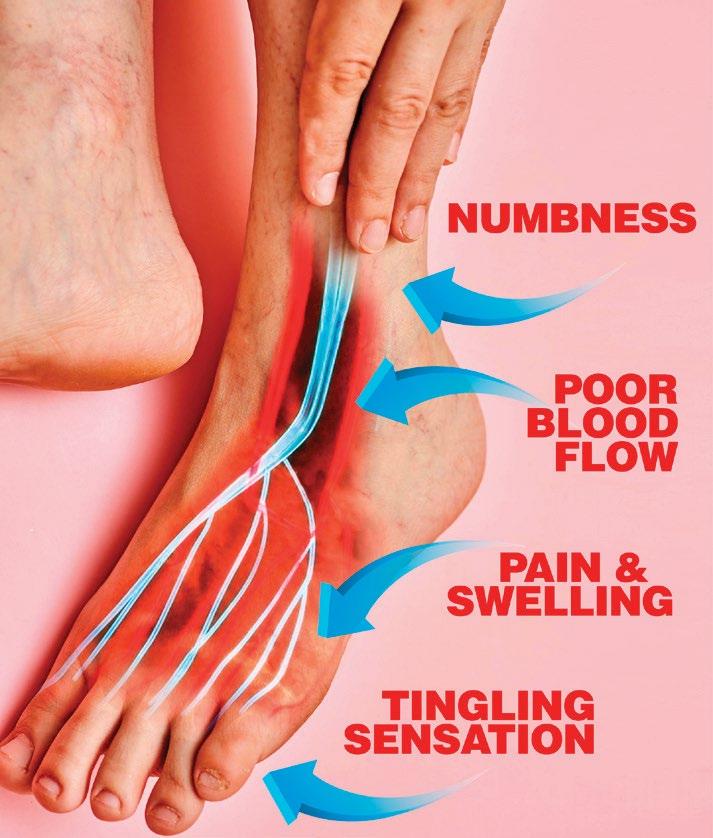
The herbs in the pill Neuro�lo strengthen your arteries that carry blood, nutrients and oxygen to your feet and legs. It improves your circulation so oxygenated blood goes to the nerves and repairs them. This makes your nerves grow stronger so your pain fades away and your legs and feet feel much younger again.
WORKS IN AMAZING WAY: A prickly plant was used in Europe in the 1600s to revitalize ailing legs. Lost over the centuries, it is now making a comeback as US doctors rediscover its impressive results – sending relief to thousands of users with:

• Burning, Tingling, Numbness
• Swollen, Achy Feet
• Painful Legs & Feet
• Varicose Veins
doctor who has appeared on award winning TV shows.
Swollen legs are a warning sign. They mean blood and fluid is forced out of the blood vessels into the surrounding tissue. This causes non-stop pain. This is where Neuroflo’s active ingredient is such a big help.
couldn’t even drive the car. With Neuro�lo I have
Katerina King from Murrieta, California says, “I had hands and feet tingling and snapping and burning feeling. It made my life very uncomfortable. I had a hard time walking, my legs felt like they each weighed 50 pounds. Once I got in my car and my feet felt so heavy I couldn’t even drive the car. With Neuro�lo I have no more tingling, cold or burning painful legs and feet. It went away.”
WHAT DOCTORS ARE SAYING
“Now I �inally have a natural solution I can recommend to my patients who suffer from leg and feet problems and pain. I’m delighted because previous treatments were not effective, but Neuro�lo has worked for every one of my patients with no side effects” says Dr. Eric Wood, N.D.
Dr. Ryan Shelton, M.D. says “This is new and different. It works for people who’ve tried many other things before. It is natural with no side effects. Don’t give up hope for your leg and feet pain, burning, tingling and numbing. This pill is working for countless people after other treatments have failed them. I highly recommend it.”
Now you can get a good night’s sleeppeaceful, restful sleep – with no pain, tingling, zinging, itching or zapping. Improve your balance and coordination. No side effects – safe to take with other medications. Enjoy your favorite activities and hobbies again. Be more active, have more fun, enjoy life more. Don’t risk irreversible damage to your feet and hands. Don’t get worse and wind up in the hospital or a nursing home.
Neuro�lo is GUARANTEED to work for you – or you will get full refund with a 90-day unconditional money-back guarantee. It is NOT sold in stores or online. No prescription or doctor visit is required.
50% OFF FOR THE NEXT 10 DAYS
This is the of�icial release of NeuroFlo in the state. Therefore, everyone who calls within the next 10 days will receive 50% OFF their �irst order. A toll-free hotline number has been set up for local readers to call for this 50% OFF savings. The number will be open starting at 7:00 am today and only for the next 10 days.
All you have to do is CALL TOLL FREE 1-855-487-6813 and provide the operator with the special 50% OFF discount approval code: NEF158.
“Neuro�lo is a terri�ic choice for people with leg and feet issues. The clinical trials in support of this herb show it is very effective for safe and fast relief,” said Dr. Wood, a Harvard trained
of this herb show it is very effective for safe and
Important: Due to Neuro�lo’s popularity and recent media exposure on ABC, CBS and FOX NEWS, phone lines are often busy. If you call and do not get through immediately, please be patient and call back. Those who miss the 10 day deadline for 50% OFF will have to pay more for Neuro�lo.

ADVERTISEMENT
These statements have not been evaluated by the Food and Drug Administration. These products are not intended to diagnose, treat, cure, or prevent any disease. Results based upon averages. Models are used in all photos to protect privacy.
If your tired, achy legs and feet are preventing you from moving easily... Now, a prickly herb has been discovered to….
CONGRATS WINNERS
High Country Summertime FLY FISHING

 BY DENNIS SMITH
BY DENNIS SMITH

Some anglers I know will tell you the best fly fishing in Colorado doesn’t really start until late June or early July. That’s about the earliest you can backpack into a cutthroat lake at 9,000 or 10,000 feet and be reasonably sure you won’t have to drill a hole in it to catch a trout. And you might have to wade through a snowbank to get to them, but the streams up there will be in pretty good shape, too. They might be running a bit high, but they’ll be clear and cold, and the fish in them will be hungry. Trout in the high country are always hungry.







They’re usually wild, too, if not authentic natives. Depending on the watershed you fish, you’ll find beautifully colored, stream-born browns, rainbows, and scattered pockets of cutthroats. And for sure, you’ll hook brook trout. In fact, the brookies will probably outnumber all the other species by at least three to one. Release the cutts, browns, and rainbows, but take a limit of the invading brookies when you leave. They’re delicious, and you’ll be doing the other fish a favor.
Fly selection varies from one fisherman to the next, but you can bet the beer money every high-country angler carries at least one Wulff pattern — probably two or three of them — in sizes 12 to 16. The Royal Wulff is a local favorite, and so is the H&L Variant. The Western version of the Ausable Wulff — tied with moose hair tails and a cream-colored rabbit-fur — is popular with the Estes Park guides I know. I like the traditional Eastern version; it has woodchuck tails and a dyed, rusty-orange Australian ’possum body.
Add a few humpies, light and dark elk hair caddis, a couple of soft hackles, a few midges for the lakes, and you’ll have most of the bases covered. You should also carry a few Adamses. The standard dry fly is fine, but the parachute version with the white calftail wing is a lot easier to see.
A few years back I discovered a small partridge and yellow soft hackle was a pretty effective match for the little yellow stone flies that hatch on my favorite headwater creek this time of year. Now, for obvious reasons, I never leave home without it. The same goes for a lightweight rain jacket. It’s not a fly pattern, I know, but it is indispensable for fly fishing the high country.
Dennis Smith is a freelance outdoors writer and photographer whose work appears nationally. He lives in Loveland. Catch up at coloradocountrylife.coop. Click on Outdoors. MISS AN ISSUE? SOME LIMITATIONS APPLY FREE SHIPPING SALE! DRtrimmer.com Go Online for FREE Catalog • 5X the power of a handheld trimmer • TRIM precisely without arm fatigue • MOW where a bladed mower can’t • TOUGHEST trimmer cord available Discover the POWER and PRECISION of a DR® TRIMMER MOWER Mary Dewey of Arvada won the copy Hot Diggity Dog we gave away in July. Mary is a member of Mountain Park Electric. Chris Nervig of Colorado Springs won the July giveaway, the “Designated Dinker” pickleball pun glass. Chris is a member of SDCEA.
We love to hear from our readers! Visit our Reader Engagement page to enter the monthly giveaway, share a funny story, submit a photo with the magazine and send a letter to the editor. Scan the QR code with your smartphone or visit coloradocountrylife.coop/reader-engagement. 24 COLORADO COUNTRY LIFE AUGUST 2023 OUTDOORS
Keep Colorado Wild
As Coloradans, we live life outside — and with that comes the responsibility for all of us to care for Colorado and keep it wild.
New this year, Colorado residents will see a $29 Keep Colorado Wild Pass added to their annual vehicle registration through the Division of Motor Vehicles. This annual pass gives all Coloradans easy access to all state parks and the added benefit of supporting our great outdoors and wildlife in a meaningful way.
Colorado is home to more than 960 species of wildlife and 23 million acres of public lands, ranging from wetlands to forests, canyon landscapes to mountain lakes. So it is no surprise that Coloradans cherish an outdoor lifestyle and want to protect the wild spaces and wildlife they treasure.
Keep Colorado Wild PassQuick Facts:
• Save 60% over the traditional annual state parks pass
• Available only with your vehicle registration process
• The $29 pass is included in your price total
• When purchased, the Colorado Parks and Wildlife (CPW) logo prints on your registration card which becomes your pass.
• No additional window sticker is provided
• Keep your registration card/pass with your vehicle
• The pass is not transferable between vehicles
• The pass can be linked to the MyCPW app


• All regularly priced Colorado state park passes are still available

• You can opt out of the pass
The Keep Colorado Wild Pass is way more than state park entry, the money raised from the pass sales supports your local:
• State parks system
• Search and rescue teams
• Avalanche safety programs
• Wildlife conservation efforts
• Outdoor learning opportunities
All of Colorado wins when you stay opted in! Join us in keeping Colorado, Colorado.
Read more about the Keep Colorado Wild Pass and how it benefits Colorado at: cpw.info/keepcoloradowildpass and cpw.info/keepcoloradowildpassspanish.
English Spanish
Staunton State Park
4-H Mobile Lab registrations are limited to Colorado’s 4-H agents. Contact your local 4-H office for details on how to bring 4-H STEM to your event.
HAVE STEM PROJECTS, WILL TRAVEL
BY TADIUS HUSER MEMBER SERVICES MANAGER HIGHLINE ELECTRIC ASSOCIATION
Colorado’s electric cooperatives are innovators in the electric industry and leaders in their communities. And your local electric co-op is always looking for new and creative ways to further its impact and connect with its members. When presented with an opportunity to give kids hands-on learning opportunities about energy concepts, the state’s electric co-ops collectively raised their hands with a clear answer: “Yes — we’ll do it.”
STATE PARTNERSHIP
In a partnership with the Colorado State University 4-H Extension, Colorado’s electric cooperatives sponsor the Mobile Energy Lab to inspire kids to learn about modern energy generation, energy sources, and energy efficiency practices.



Toby Swaford, K-12 4-H STEM state specialist at Colorado State University is passionate about engaging and educating young people and brings amazing ideas to the Energy Lab. With a background in designing user experiences, Toby creates STEM projects that are interactive and fun.
WHAT YOU WILL FIND INSIDE
The customized trailer is full of functional hands-on projects, activities, and materials focused on the experiential learning of science, technology, engineering, and mathematical concepts — all related to energy. The trailer has been used at county fairs, community events, and at schools. In March, when the trailer was at an elementary school in El Paso County, the fifth graders reported that it was “The best day ever!”
The mobile “pop-up” outdoor classroom can be used anywhere across Colorado and moves throughout the state on a rotation. Throughout the year, Toby hauls the trailer and travels to the state’s five 4-H Extension regions (southern Colorado, Front Range, Eastern Plains, mountain region, and Western Slope) where it spends roughly four months offering opportunities of fun-filled education for local kids. S T E M
The Colorado Rural Electric Member Services group sponsors the Colorado 4-H Energy Trailer.
26 COLORADO COUNTRY LIFE AUGUST 2023 FOCUS ON STEM
Colorado’s electric cooperatives sponsored Colorado 4-H Energy Lab is ready for its next stop in Colorado.
MORE INFORMATION
Scientific Discovery Stuns Doctors
Biblical Bush Relieves Joint Discomfort in as Little as 5 Days
Legendary “special herb” gives new life to old joints without clobbering you. So safe you can take it every day without worry.
According to the Centers for Disease Control and Prevention, more than 54 million Americans are suffering from joint discomfort. This epidemic rise in aching joints has led to a search for alternative treatments—as many sufferers want relief without the harmful side effects of conventional “solutions.”
Leading the way from nature’s pharmacy is the new “King of Oils” that pioneering Florida MD and anti-aging specialist Dr. Al Sears calls “the most significant breakthrough I’ve ever found for easing joint discomfort.”
Biblical scholars treasured this “holy oil.” Ancient healers valued it more than gold for its medicinal properties. Marco Polo prized it as he blazed the Silk Road. And Ayurvedic practitioners, to this day, rely on it for healing and detoxification.
Yet what really caught Dr. Sears’ attention is how modern medical findings now prove this “King of Oils” can powerfully…
Deactivate 400 Agony-Causing Genes
If you want genuine, long-lasting relief for joint discomfort, you must address inflammation. Too much inflammation will wreak havoc on joints, break down cartilage and cause unending discomfort. This is why so many natural joint relief solutions try to stop one of the main inflammatory genes called COX-2.
But the truth is, there are hundreds of agonycausing genes like COX-2, 5-LOX, iNOS, TNK, Interleukin 1,6,8 and many more—and stopping just one of them won’t give you all the relief you need.
Doctors and scientists now confirm the “King of Oils”—Indian Frankincense—deactivates not one but 400 agony-causing genes. It does so by shutting down the inflammation command center called Nuclear Factor Kappa Beta.
NK-Kappa B is like a switch that can turn 400 inflammatory genes “on” or “off.” A study in Journal of Food Lipids reports that Indian Frankincense powerfully deactivates NF-Kappa B. This journal adds that Indian Frankincense is “so powerful it shuts down the pathway triggering aching joints.”
Relief That’s 10 Times Faster… and in Just 5 Days
Many joint sufferers prefer natural solutions but say they work too slowly. Take the bestseller glucosamine. Good as it is, the National Institutes of Health reports that glucosamine takes as long as eight weeks to work.
Yet in a study published in the International Journal of Medical Sciences, 60 patients with stiff knees took 100 mg of Indian Frankincense
or a placebo daily for 30 days. Remarkably, Indian Frankincense “significantly improved joint function and relieved discomfort in as early as five days.” That’s relief that is 10 times faster than glucosamine.
78% Better Relief Than the Most Popular Joint Solution
In another study, people suffering from discomfort took a formula containing Indian Frankincense and another natural substance or a popular man-made joint solution every day for 12 weeks.
The results? Stunning! At the end of the study, 64% of those taking the Indian Frankincense formula saw their joint discomfort go from moderate or severe to mild or no discomfort. Only 28% of those taking the placebo got the relief they wanted. So Indian Frankincense delivered relief at a 78% better clip than the popular man-made formula.
In addition, in a randomized, double blind, placebo controlled study, patients suffering from knee discomfort took Indian Frankincense or a placebo daily for eight weeks. Then the groups switched and got the opposite intervention. Every one of the patients taking Indian Frankincense got relief. That’s a 100% success rate— numbers unseen by typical solutions.
In addition, BMJ (formerly the British Medical Journal) reports that Indian Frankincense is safe for joint relief — so safe and natural you can take it every day.
Because of clinically proven results like this, Dr. Sears has made Indian Frankincense the centerpiece of a new natural joint relief formula called Mobilify
Great Results for Knees, Hips, Shoulders and Joints
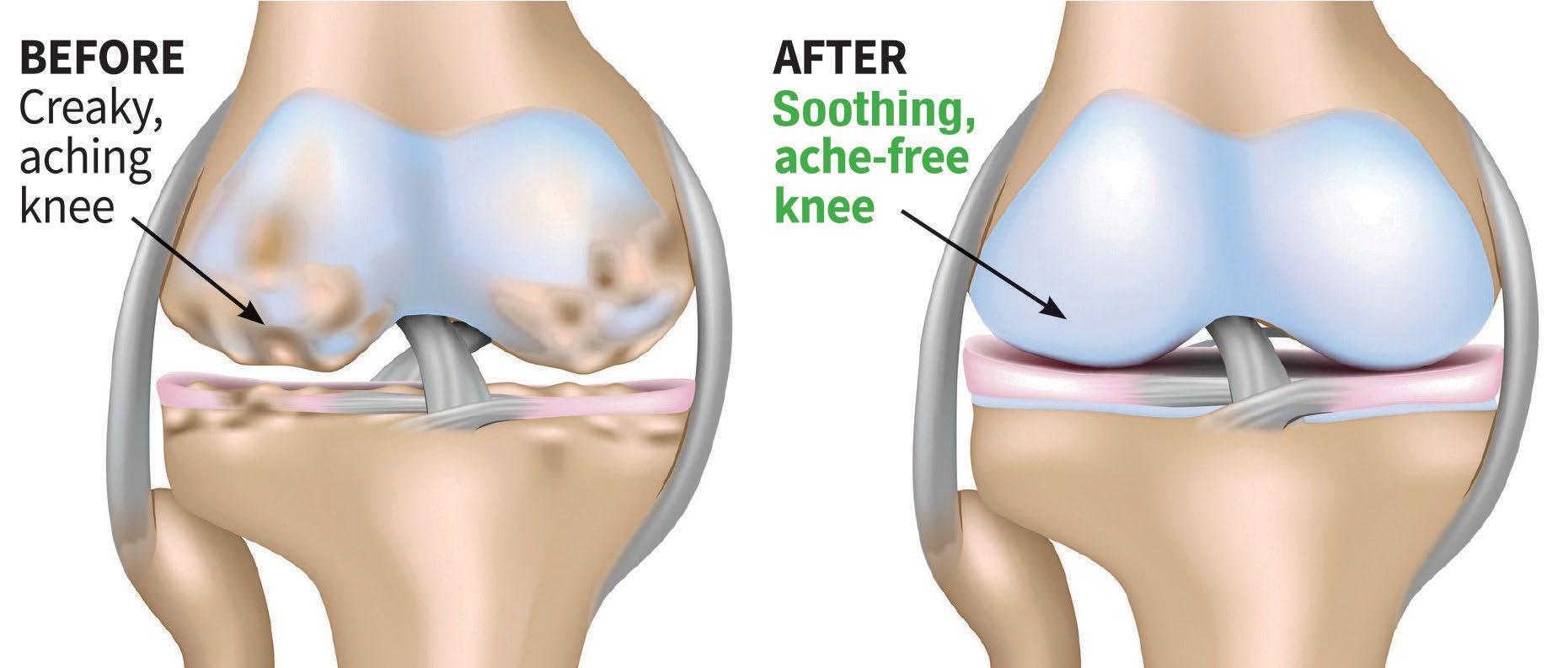
Joni D. says, “Mobilify really helps with
soreness, stiffness and mild temporary pain. The day after taking it, I was completely back to normal—so fast.” Shirley M. adds, “Two weeks after taking Mobilify, I had no knee discomfort and could go up and down the staircase.” Larry M. says, “After a week and a half of taking Mobilify, the discomfort, stiffness and minor aches went away… it’s almost like being reborn.” And avid golfer Dennis H. says, “I can attest to Mobilify easing discomfort to enable me to pursue my golfing days. Definitely one pill that works for me out of the many I have tried.”
How to Get Mobilify
Right now, the only way to get this powerful, unique formula that clobbers creaking joints in as little as five days without clobbering you is with Dr. Sears’ breakthrough Mobilify formula. It is not available in stores.
To secure your bottle of this breakthrough natural joint discomfort reliever, buyers should call with Sears Health Hotline at 1-800-329-8498. “The Hotline allows us to ship the product directly to customers.”
Dr. Sears believes in this product so much, he offers a 100% money-back guarantee on ever order. “Just send me back the bottle and any unused product within 90 days, and I’ll send you your money back,” said Dr. Sears.
The Hotline will be taking orders for the next 48 hours. After that, the phone number may be shut down to allow them to restock. Call 1-800-329-8498 to secure your limited supply of Mobilify. If you are not able to get through due to extremely high call volume, please try again! Call NOW to qualify for this limited time offer provided at a significant discount. To take advantage of this exclusive offer use Promo Code: COMB823 when you call.
ADVERTISEMENT
THESE STATEMENTS HAVE NOT BEEN EVALUATED BY THE FOOD AND DRUG ADMINISTRATION. THIS PRODUCT IS NOT INTENDED TO DIAGNOSE, TREAT, CURE OR PREVENT ANY DISEASE. RESULTS MAY VARY FROM PERSON TO PERSON. NO INDIVIDUAL RESULT SHOULD BE SEEN AS TYPICAL. 9
The active ingredient in Mobilify soothes aching joints in as little as 5 days
Get an exclusive first look at our monthly contests and upcoming stories. Scan the QR code above to get the CCL Extra digital newsletter delivered straight to your inbox twice a month. ARE








Submit your best works on our Reader Engagement page at www.coloradocountrylife.coop or send it in an email to poetry@ coloradocountrylife.org. Remember to include the name of your electric co-op and your mailing address.






















Submit your nominations by September 15. Participants will be entered to win one of three $100 gift cards, if they nominate in at least three categories. Share your favorites at coloradocountrylife.coop/bestof2023 HELP US FIND THE BEST OF COLORADO! WE’RE LOOKING FOR THE BEST: • Burger • Brunch • BBQ • Ice Cream • Pie • Green Chile Encourage young sportsmen by providing safe, private access. You make the rules. 303-460-0273 Stop feeding prairie dogs. We’ll rent hunting rights from you. Seriously looking for duck & goose habitat. Wanted: Jeep CJ or Wrangler. Reasonably priced No rust buckets. 888-735-5337 Buying Colored Pyrex — Griswold & Wagner cast iron — cowboy hats, boots & spurs. 970-759-3455 or 970-565-1256 WE PAY CASH for minerals and oil/gas interests, producing and non-producing. 800-733-8122 POLE BARNS S Specializing in Post Frame Metal Buildings for your Farm, Machines, Animals, Barndominium, Commercial building... or anything you can think up! Custom Pole Barns ACROSS COLORADO for a custom Quote Call Boone today! www.aandcbuilders.com E S T 1 9 7 5
YOU A POET?
28 COLORADO COUNTRY LIFE AUGUST 2023 MARKETPLACE
25th anniversary.
Don’t forget to pack a copy of CCL for your next trip!



Show us where you enjoy CCL for a chance to win! Simply take a photo of someone (or a selfie!) with the magazine and share it with us on the Reader Engagement page at coloradocountrylife.coop. Each month we’ll draw one photo to win $25. The next deadline is Friday, August 18. See all of the submitted photos on Facebook at facebook.com/ COCountryLife.

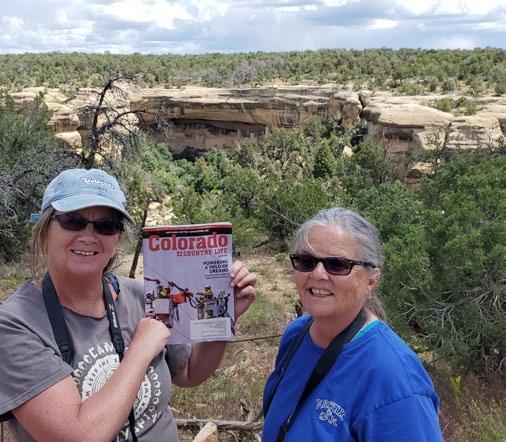
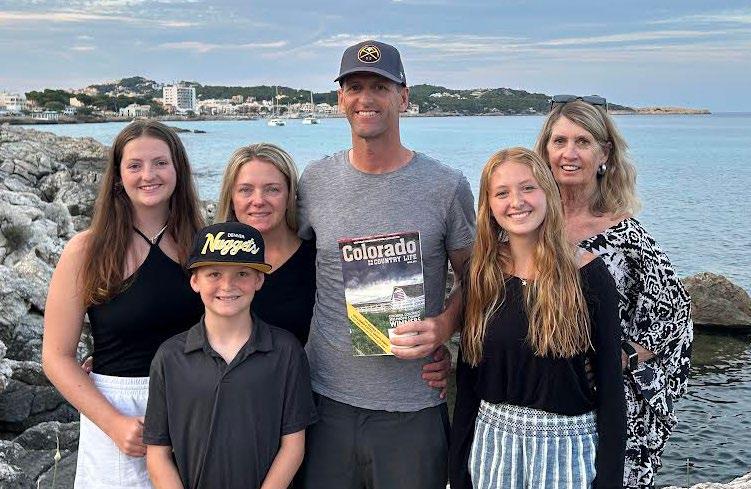
In one of my impromptu lessons as a preschool teacher, my students and I were discussing what animals give us what food. All the usuals were coming up: cows equal hamburgers, bacon from pigs, etc. One of my students piped up with llamas. A little confused, I asked, "What food do we get from llamas?" She replied proudly, "Llama beans!"

Derek Smith, Peyton Mountain View Electric Association member
My 3-year-old granddaughter, Georgia, was visiting one day. I asked her what she wanted to be when she grew up. She thought for a moment and looked at me with that sweet little face and said, "I think I still want to be Georgia." Well put, little girl, well put!
Marcella Scamehorn,
Longmont Poudre Valley REA member
My 8-year-old son was at church one week when his teacher asked if any of the kids had any prayer requests. The kids were asking God to help their gardens grow. My son raised his hand and asked that God help his pot garden to grow. His teacher said, “Excuse me?” I immediately started giggling because this year we planted our garden in pots instead of in the ground. (His garden is growing quite nicely.)
Megan Geiger, Fruita Grand Valley Power member
We pay $15 to each person who submits a funny story that’s printed in the magazine. At the end of the year we will draw one name from the 2023 published funny stories and that person will receive $200. Send your stories to Colorado Country Life, 5400 Washington St., Denver, CO 80216 or email funnystories@coloradocountrylife.org. Don’t forget to include your mailing address, so we can send you a check.
READERS’ PHOTOS FUNNY STORIES
WINNER: Clay Anderson and his family, members of Southeast Colorado Power Association, snap a photo with CCL on the island of Mallorca in Spain.
Patti and Clayton Wilshusen travel to Ketchikan, Alaska, with CCL during a cruise from Whittier Alaska to Vancouver BC, Canada. Patti and Clayton are members of Poudre Valley REA.
Michele Bremer makes time before her swim across the Tropic of Cancer to pose with CCL in the Bahamas. Michele is a member of Mountain View Electric.
DeDe Downs and Terry Wise bring CCL to the Cliff Palace Overlook at Mesa Verde National Park. Both gals are members of San Isabel Electric.
Proud father Yosef Salzano snaps a photo with CCL during his daughter Rachel’s PhD graduation in Edinburgh, Scotland. The Salzanos are members of Poudre Valley REA.
Mountain Parks Electric members Keith and Lorena Johnson take CCL to Israel to celebrate their
Congratulations, Keith and Lorena!
29 COLORADO COUNTRY LIFE AUGUST 2023 YOUR STORIES
Nourishing & Nurturing Colorado Kids
FocusedKids
FocusedKids partners with schools, families, and community organizations to teach mindful self-regulation and brain-building techniques to prioritize healthy brains in children. This research-based social and emotional learning model teaches participants about their brain, helps develop self-awareness, and improves focus both in and out of the classroom.

FocusedKids works with kids as young as two years old in preschool through fifth grade. When used in a classroom setting, FocusedKids meets with teachers for professional development training to explain why the work is important. The FocusedKids team then meets with the whole classroom to teach over a three-week period. Following the three-week program, FocusedKids supports program participants by providing a year-long professional development course as a foundational building block for teachers to successfully manage their classrooms and show up for their students. FocusedKids extends beyond the classroom as well, partnering with parents to provide personalized sessions for their kiddos. To learn more about how this program could work for you and see how they’re making a difference, visit focusedkids.org.
There are countless nonprofits around Colorado doing wonderful work. These three organizations are on a mission to nurture and support their local communities in unique ways. Read on to learn more about these nonprofits and get inspired to pay it forward.

Mountain Roots Food Project
Mountain Roots Food Project is committed to bettering the local food system with a variety of communitybased classes and programs. Based in the Gunnison Valley, the goal of this nonprofit is to foster knowledge and provide opportunities for accessible, affordable, and nutritious food that benefits the local economy and is sustainably produced. Mountain Roots Food Project was founded in 2010 and its first 2,100 square foot urban garden produced more than 600 pounds of food that was donated to local schools and food pantries and offered to volunteers. In 2022, Mountain Roots Food Project began three new community partnerships at the community gardens in the Gunnison Valley, including collaborations with Inmigrantes Unidos; a garden club for women, infants, and children; and support groups in partnership with Project Hope.
Mountain Roots Food Project offers a variety of hands-on experiences, including teaching environmental science in K-12 schools, kids cooking classes, school gardens, a weekly farm stand, middle school nutrition curriculum, high school internships, and a post-graduation “Beginning Farmer Training Program” that teaches regenerative agriculture to the next generation. To volunteer, make a donation, or get more information, visit mountainrootsfoodproject.org.
Did you know that one in seven children in the United States is unsure where they will get their next meal? This is often due to a lack of financial resources in the household and is an issue more prevalent in Colorado than you may think. Beef Sticks for Backpacks was created by members of the Colorado agriculture community with the goal of helping children who experience food insecurity in Colorado. In partnerships with local sponsors including Colorado Cattlemen’s Association, the Colorado Livestock Association, and Colorado State University, Beef Sticks for Backpacks provides high-quality, protein-rich beef sticks to numerous counties throughout the state. Beef Sticks for Backpacks has distributed a total of 1,561,727 beef sticks since 2019. Today, every single child in Larimer County receives a beef stick on a weekly basis. This Colorado-grown nonprofit’s commitment to both quality ingredients and ending childhood hunger in Colorado is what makes it shine, and it hopes to one day serve the entire state with its weekly program. You can get involved with Beef Sticks for Backpacks by visiting beefsticks.org.
 Photo courtesy of FocusedKids.
Photo courtesy of Mountain Roots Food Project.
Photo courtesy of FocusedKids.
Photo courtesy of Mountain Roots Food Project.
30 COLORADO COUNTRY LIFE AUGUST 2023 DISCOVERIES
Photo courtesy of Beef Sticks for Backpacks.
UPGRADE YOUR HVAC AND SAVE
Looking to comfortably heat your home this winter while being more efficient, environmentally friendly, and still save money? Consider a high-efficiency heat pump!
+ HEATS EFFICIENTLY IN SUB-ZERO TEMPERATURES
Modern cold climate heat pumps can heat homes efficiently down to -13°F and operate in sub-zero temeratures as low as -20°F.
+ IMPROVES YOUR HOME’S AIR QUALITY
Natural gas and propane furnaces generate heat by burning a mixture of fossil-fuel and air. Heat pumps don’t use combustible fuel to create heat which eliminates potential exposure to dangerous combustion byproducts such as carbon monoxide.
+ SAVES MONEY COMPARED TO ELECTRIC BASEBOARD HEAT OR PROPANE FURNACES
A heat pump can transfer up to 300% more energy than it consumes, compared to a high-efficiency propane furnace’s 95% rating. Because of this, electric heat pumps can also save substantially on fuel consumption.
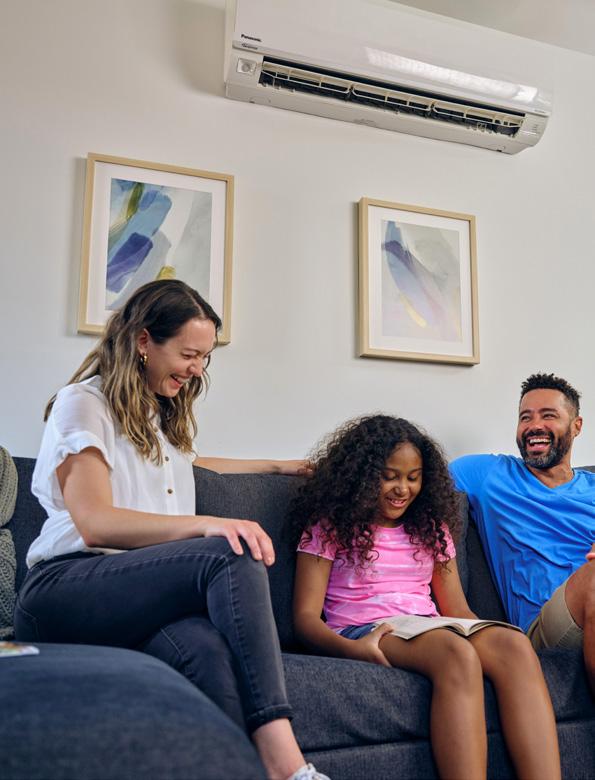
VISIT US AT www.tristate.coop/BE

Tri-State is a not-for-profit power supplier to cooperatives and public power districts in Colorado, Nebraska, New Mexico and Wyoming.
ELECTRIFY AND SAVE
Why Renewal by Andersen?
• Renewal by Andersen is the full-service replacement window division of Andersen, a 120-year-old family-owned company with a reputation for excellence in window and door craftsmanship.
• Our exclusive composite Fibrex® windows are not only beautiful, they’re remarkably strong, offer superior energy efficiency and require minimal maintenance.3

• Our factory-trained Certified Master Installers have years of experience installing only windows and doors, and they’ll treat you and your home with the utmost respect.

1Subject to availability, on a total purchase of 4 or more. Buy 2 windows or doors and get the second 2 windows or doors, of equal or lesser value, 40% off – applied to lowest priced window and/or door products in purchase. $400 discount valid during first appointment only. Cannot be combined with other offers. To qualify for discount offer, initial contact for an appointment must be made and documented on or before 8/31/23 with the purchase then occurring on or before 9/10/23. 2No payments and deferred interest for 12 months available from third-party lenders to well qualified buyers on approved credit only. No Finance Charges will be assessed if promo balance is paid in full in 12 months. 3See limited warranty for details at https://www.renewalbyandersen.com/homeowner-help/warranty. *National Replacement Window Month is not a Congressionally-approved designation. Products are marketed, sold and installed (but not manufactured) by Renewal by Andersen retailers, which are independently owned and operated under Window Warmth, LLC d/b/a Renewal by Andersen of Colorado. See complete information and entity identification at www. rbaguidelines.com. ©2023 Andersen Corporation. ©2023 Lead Surge LLC. All rights reserved.

303-562-2548 AUGUST is National Replacement Window Month at Renewal by Andersen* TopWindowsColorado.com
did we declare August National Replacement Window Month? Because even though the summer is hot, that doesn’t mean you have to live with the heat inside your home, too. Replacing just a few windows or a door now can help make your home cooler during the summer—and warmer in the winter. Call or scan the code to book your FREE Window & Door Diagnosis for 1 year2 Down Payments Interest with plus Buy one window or door, get one Take an extra $400 off your entire order1 $0 0 0% Call before August 31! 40% OFF1 Scan to self-schedule your appointment
Why































































 BY RITA-LYN SANDERS DIRECTOR OF MARKETING AND COMMUNICATIONS
BY RITA-LYN SANDERS DIRECTOR OF MARKETING AND COMMUNICATIONS


 As a powerful and intuitive app, the SmartHub mobile app homescreen offers simple navigation buttons for billing and payments, usage, and notifications.
This is what a summary of weekly usage looks like in the SmartHub mobile app.
As a powerful and intuitive app, the SmartHub mobile app homescreen offers simple navigation buttons for billing and payments, usage, and notifications.
This is what a summary of weekly usage looks like in the SmartHub mobile app.



 BY DESTRY SMITH ENERGY SERVICES ADMINISTRATOR
BY DESTRY SMITH ENERGY SERVICES ADMINISTRATOR



































 Recipe and photo by Catherine Murray, Ohio Cooperative Living.
Recipe and photo by Catherine Murray, Ohio Cooperative Living.











 —Rob Zahller
Gayle Gresham was honored to strum along with Rob Zahller’s guitar class. She learned guitar in a sixth grade class and still plays in a bluegrass-gospel group with her husband. Gayle writes from her home in Elbert, Colorado.
A guitar signed by the kids who took his guitar class in 2016 is a point of pride for Rob. He recalls it was a group of kids who meshed perfectly and made great music.
Mr. Zahller’s classroom is home to plenty of guitars and music. Songs by Johnny Cash are a favorite among students.
—Rob Zahller
Gayle Gresham was honored to strum along with Rob Zahller’s guitar class. She learned guitar in a sixth grade class and still plays in a bluegrass-gospel group with her husband. Gayle writes from her home in Elbert, Colorado.
A guitar signed by the kids who took his guitar class in 2016 is a point of pride for Rob. He recalls it was a group of kids who meshed perfectly and made great music.
Mr. Zahller’s classroom is home to plenty of guitars and music. Songs by Johnny Cash are a favorite among students.









 BY DENNIS SMITH
BY DENNIS SMITH




















































 Photo courtesy of FocusedKids.
Photo courtesy of Mountain Roots Food Project.
Photo courtesy of FocusedKids.
Photo courtesy of Mountain Roots Food Project.






